Category: Uncategorized
I was the first foreign pilot to fly the Mach 2.8 MiG-31 interceptor, here’s my story: By Air Marshal Anil Chopra (Retd)

Weighing the same as a M60 main battle tank and capable of flying 600mph faster than an F-16, the Russian MiG-31 is an absolute beast of an interceptor. Cloaked in secrecy, few outsiders have flown in the cockpit of this monstrous defender. Air Marshal Anil Chopra PVSM AVSM VM VSM (Retd) was given privileged access to the world’s fastest armed aircraft, here he describes this incredible experience to Hush-Kit.
“I felt I was sitting atop a missile-head in a high-speed interception.”

“The date was 28 May. Average daytime temperatures in May in Nizhnie Novgorad are around 22℃. Airfield elevation was 256 ft. The take-off and landing were done by the front pilot. The rear cockpit is used mostly as Weapon System Officer (WSO) station, though it has a control column to fly in case of an emergency requirement. There was nothing peculiar about the take-off. The frontal view through the periscope was good. I had used the periscope earlier on MiG-21UB (trainer) and on the MiG-23UB. So, I was quite comfortable. However the side view was minimal as the large front canopy left little place for Perspex for the second cockpit. I tried to visualise if the second pilot could easily land from the rear seat. Compared to a Su-30MKI it is surely more uncomfortable.”
Why did you try the MiG-31?
“I was the team leader of the Indian Air Force (IAF) MiG-21 Upgrade ‘Bison’ project in Russia from mid-1996 to the end of 2000. The design and development work was carried out at the Mikoyan Design Bureau in Moscow’s (OKB-155, Experimental Design Bureau 155). Our location was at RAC ‘MiG’, 6, Leningradskoye Shosse, Moscow. In 1995, Mikoyan OKB had merged with two production facilities to form the Moscow Aviation Production Association MiG (MAPO-MiG). Rostislav A. Belyakov, was still the father figure. I had an opportunity to meet him.”
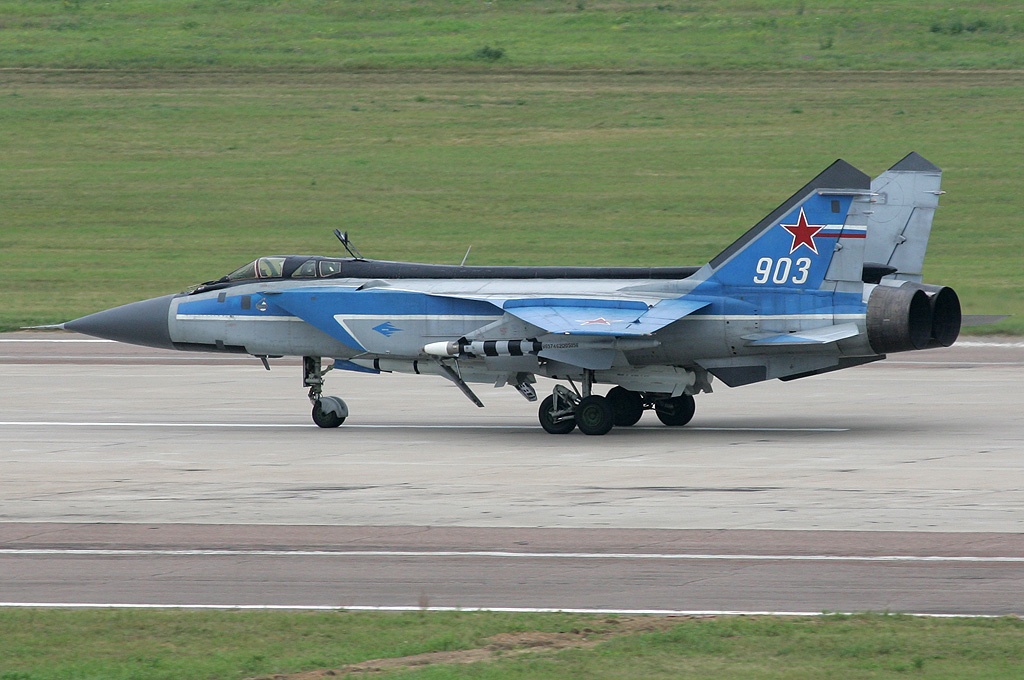
“Two MiG-21Bis Aircraft had been sent from India for the design and development project. These aircraft were in positioned at the Sokol plant in Nizhnie Novgorod, where they were to be stripped and rebuilt after receiving the final design drawings from the Moscow Design Bureau. Sokol was also where the MiG-31 was being built. Our team used to visit the Sokol plant regularly from 1997, nearly once a month, for progressing the work on our two aircraft. Two of our officers were later permanently at Sokol for the flight testing of the Bison. The Director General of the plant, V Pankov mentioned to me about the MiG-31 and said that the Russians had been proposing the MiG 31 for sale to India. He said that they had given details to both the Government of India and to the Indian Air Force, but had not received any response or interest. I asked them to show us the aircraft, and if they had no problem, then I could get a chance to fly it. In Russian armament industry the general dynamics were still of the Soviet era. It took him some time to get approvals for me to fly in the rear seat of the MiG-31. They also told me that I was to be the first pilot from a foreign country to fly a MiG-31. They gave me a certificate to that effect, which is currently lying misplaced somewhere in my boxes. It was a demonstration flight and not a test flight. The basic aim was to show case the long range radar and to demonstrate high speed and acceleration. The date fixed was 28th May 1999. That was also the day the deputy head of India’s Mission in Moscow was on her first official visit to the Sokol plant. Ms Nirupama Rao was later India’s foreign secretary and India’s Ambassador to USA.”
Where did you fly it?

“The flight was made in the Sokol Aircraft Plant in Nizhniy Novgorod, which was formerly called Gorky. The plant was a manufacturer of MiG fighters. It was reportedly founded in 1932 and was once known as ‘Aviation Plant 21’, named after Sergo Ordzhonikidze. During 45 years of serial production the plant had manufactured about 13,500 combat aircraft. We were told that at its peak, they use to make close to 200 MiG-21s a year. But after the collapse of Soviet Union, and in the absence of significant orders from the Russian Air Force Voyenno-Vozdushnye Sily (VVS), the production had gone down. The Indian MiG-21 upgrade was a significant order. Also, the plant used to make around 10-12 MiG 29 two-seaters in a year. There were nearly 15,000 employees. Their salaries were very low in the mid 1990s. Most of the sales and money earned from armaments was controlled directly from Moscow. All foreign contracts were through Rosvooruzhenie (later Rosoboronexport), the sole state intermediary agency for Russia’s exports/imports of defence-related and dual use products, technologies and services. We were told that the entire plant, including salaries could be run through the sale of just two MiG-29s. It was clear that the aircraft sale price was very high and basic production costs and salaries were very low. The high mark-ups of defence equipment prices are true in all countries. For some exported components, the price mark-up could be a 100 times. Many smaller plants that were the real original equipment manufacturers (OEM) of the components or sub-systems, wanted to sell spares directly to India, but the Russian government control was never released and with the result that the bulk of the profits went to Moscow.”
Interview with Indian Air Force MiG-29 pilot here
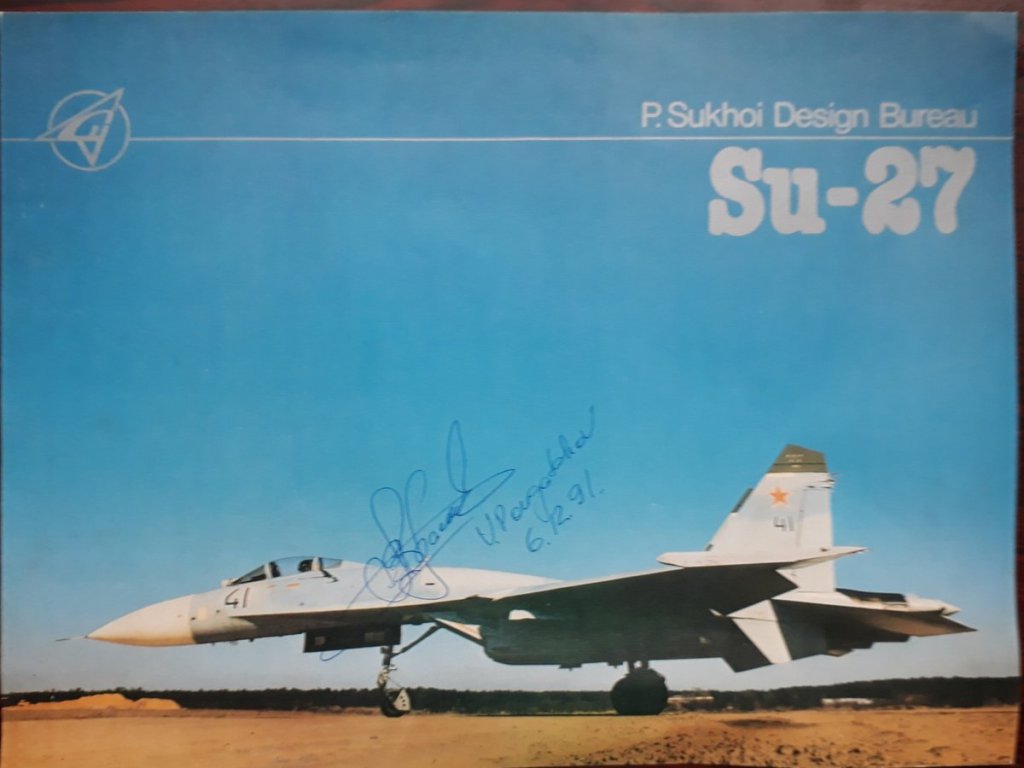
Russian people take a little time to make friends, but once they become one, they are great friends. There were many very senior technicians in the plant who had been to India in 1960s to help set up the MiG plant at Nasik. They had fond memories and spoke about the great time they had in India, and how they loved Indians. They also remembered the great Indian Old Monk Rum. We arranged to get some from India for them.

The production facility was next to the airfield (also known as Sormovo airfield), which was also the civil airport. For a long time, the plant was considered the most important industrial enterprise and main employer of the region. In those hard days, the plant was making many aluminium and other alloy based products, like river boats, frames for doors and windows, and even metro coach shells. We have heard that in later years they even encouraged flight tourism for MiG-29 to generate additional income.”
General Capability Briefing by the Russian Designers

“The MiG-31BM that I was to fly was reportedly a multirole version with partially upgraded avionics, new multimode radar, HOTAS controls, LCD colour multi-function displays (MFDs) in front cockpit, and ability to carry the R-77 missile and other Russian air-to-ground missiles (AGMs) such as the Kh-31 anti-radiation missile (ARM). It also reportedly had a new and more powerful computer, and digital data links. The aircraft was called Prospective Air Complex for Long-Range Interception. The Zaslon phased-array PESA radar would allow firing long-range air-to-air missiles. Its maximum range against fighter-sized targets was claimed as 200 km. The radar could track up to 10 targets and simultaneously attack four of them with its Vympel R-33 missiles, they said. But eventually the radar would track 24 airborne targets at one time, and attack six simultaneously, they said. Actual development status of radar at that time was not known to us. An upgraded, larger Zaslon-M radar, would later have detection range of around 400 kilometres for AWACS class targets.
There was an infrared search and track (IRST) system in a retractable under nose fairing. Its tracking range was 56 kilometres. The eventual variants were to have various air-to-ground missiles integrated, that included six anti-radiation missiles, or anti-shipping missiles or six precision TV/Laser bombs like KAB-1500. Maximum external load mass was 9,000 kilograms. The MiG-31’s main armament was four R-33 air-to-air missiles. Fuselage could reportedly carry four R-33 or six R-37 missiles. Four underwing pylons could carry combinations of drop tanks and weapons. MiG-31BM could also carry the Kh-47M2 nuclear-capable air-launched ballistic missile with a claimed range of more than 2,000 km, and a Mach 10 speed.

The MiG-31 was equipped with digital secure data-links. Details were not told, but they mentioned that the aircraft radar picture could be transferred to Indian Su-30s and MiG-29s. Also the ground radar picture could be received by the MiG-31 and transferred electronically to other aircraft. Thus allowing radar-silent attacks. There was a choice to slew missiles and fire based on inputs from other aircraft through the data-link. The MiG-31 had radar ECMs. Details were not discussed. The onboard navigation and attack system had two inertial systems supported by digital computer.

A detailed briefing on the aircraft was carried out first by Russian designers, and then was the pre-flight briefing by the pilot. Designers told us that though evolved from the MiG-25, there were significant changes. The aircraft fuselage was longer to accommodate the radar operator’s cockpit and there were some other new design features. The wings and airframe of the MiG-31 were stronger than those of the MiG-25. The advanced radar, with look-up and look-down/shoot-down capability and multi target tracking and engagement was a significant improvement. The aircraft had advanced sensors and weapons. Radar they said was much better and worked well even during active radar jamming. They highlighted cooperative work, between a formation of four MiG-31 interceptors, using data-links, which could dominate a large front and airspace across a total length of up to 900 kilometres. The radar had maximum detection range of 200 kilometres. They claimed that the aircraft radar and weapons combination could intercept cruise missiles flying at low altitude, and also the launch aircraft. Similarly it could take on UAVs and helicopters. The automatic tracking range of the radar was 120 kilometres. The aircraft could act as air defence escorts to a long range strategic bombers. The MiG-31 was not designed for close combat or high-g turning.
They also mentioned that the Russian Air Force was already flying the MiG-31, and a few hundreds had been produced by the Sokol plant. The Kazakhstan Air Force had also retained some numbers after Soviet dissolution. They took pride in mentioning that the MiG-31 was among the fastest combat jets in the world. The aircraft had years of service ahead. Cash-strapped Russia was very keen for the IAF to buy the MiG 31.
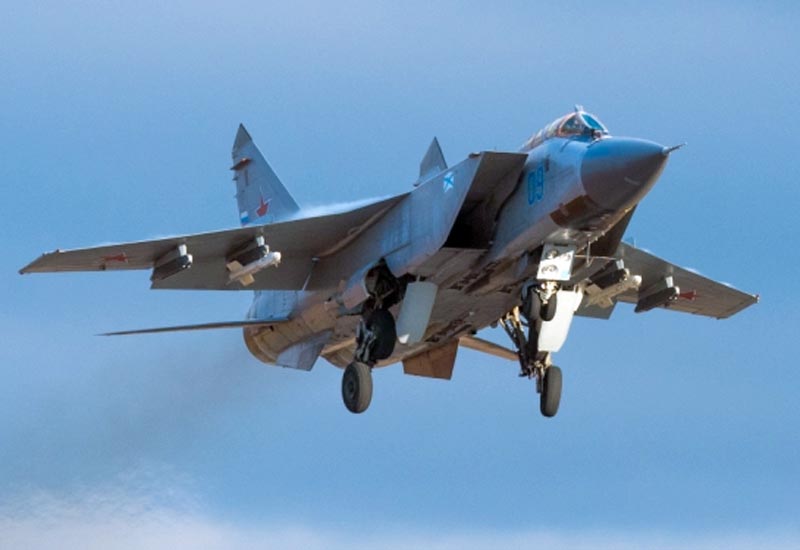
What were your first impressions?

The blue and white painted huge aircraft with tail number 903 looked most impressive and overbearing as one walked towards it. To start with, the MiG-31 is big. You might say huge. This was the then under development MiG-31BM (air defence) variant. I had read up about the MiG-31. I had earlier seen the MiG-25 in India, though I had not flown it. This one was freshly painted aircraft and much better looking. This was the aircraft which was to be used for display during air shows. As one walks around the aircraft for external checks, one gets to see the huge nose cone that housed the RP-31 N007 ‘backstop’ (Russian: Zaslon) radar. Air intakes were side-mounted ramps. Looking into the huge intake was like looking into a tunnel, and one could see the first stage of the huge engine. With a high shoulder-mounted wing, one could comfortably walk under the aircraft. The undercarriage was peculiar. There were two main wheels in each side and these were in Tandem but not aligned with each other. We were told that the undercarriage had been strengthened to take greater weight, also the fuselage was clearly longer. One recalled that the MiG-25 had only one main wheel each side. Russians also demonstrated the peculiar way the wheels retracted into the fuselage. The wheel trolley did a full forward rotation before entering the wheel bay. The tail side was somewhat similar to MiG-25, though longer a little but difficult to make out.
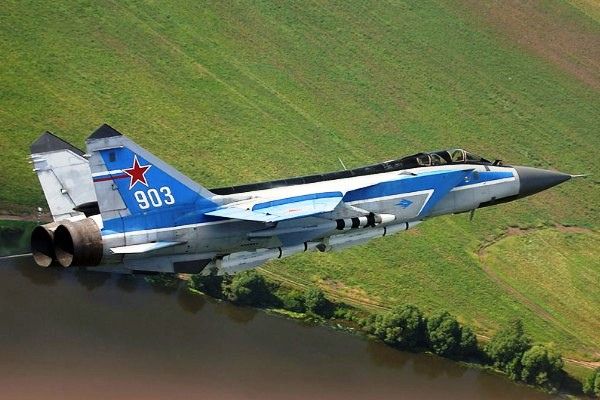
On entering the cockpit, I was briefed by the pilot, Alexander Georgiyevich Konovalov. We were not allowed photography in the cockpit. The front cockpit was still like the other Russian cockpits with green colour and standard old instrumentation. There were two MFDs which had been introduced in the front cockpit. It looked like a cut and fit task as is the case in developmental aircraft cockpits. The rear cockpit had the old round CRT radar scope. The front cockpit had a standard Russian control column with autopilot and weapon controls. The rear seat had a control stick with no control buttons on the stick-head. This rear-stick could also be removed and stowed away for better radar work. Once the canopy was closed the outside view reduced considerable in the rear cockpit. One got a feeling as if one was seated in a submarine. There was a big periscope to see outside. The cockpit seemed more optimised for WSO role and less for flying.”
How does it compare with the MiG-25?
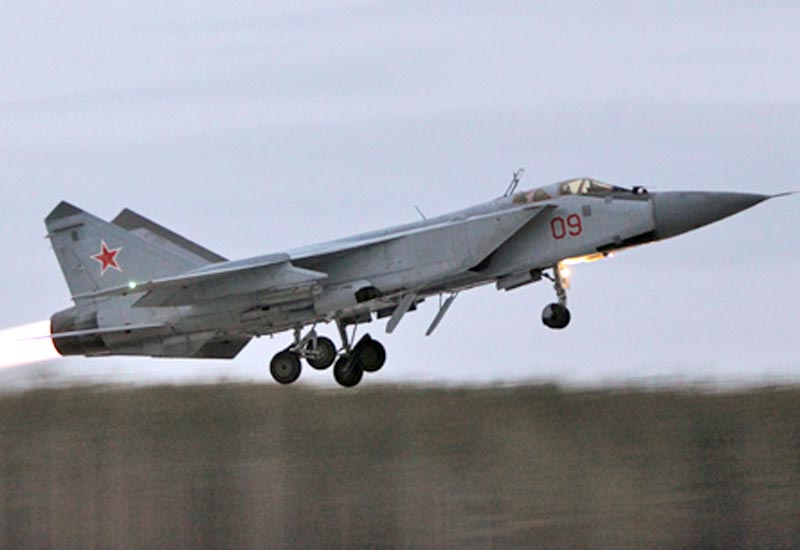
Both the MiG-25 and MiG-31 were designed as interceptors. The MiG-31 was greatly upgraded to house an advanced radar, digital data links and the more powerful engines. The aircraft had to be made longer. The gross weight of MiG-31 had gone up to 41,000 kg (90,390 lb) vis-à-vis the 36,720 kg (80,954 lb) of the MiG-25. The MiG-31 had two Soloviev D-30F6 engines with 93 kN (21,000 lbf) dry thrust each dry, and 152 kN (34,000 lbf) with afterburner, compared to two Tumansky R-15B-300 engines, with 73.5 kN (16,500 lbf) dry thrust, and 100.1 kN (22,500 lbf) with afterburner for MiG-25.

The MiG-31 was clearly an upgraded design, though it would be wrong to call it a totally new design. Strengthened wings allowed a small increase in max G from 4.5 to 5G, and better acceleration and low-level flight. The MiG-25 radar, was primarily optimised for high-flying targets, but the Zaslon radar of the MiG-31 could detect and track low flying aircraft (look-down/shoot-down capability). The same was demonstrated in flight by locking on to a low-flying MiG-21 that had taken off from same airbase. The rear cockpit in the MiG 31 has been optimised for the Weapon System Operator. The WSO was entirely dedicated to radar operations and weapons deployment. The MiG-31 radar was passive electronic scanned array (PESA) whereas the MiG-25 had older variants of vacuum tube or semiconductor radars. While the MiG-25 (generally) carried only air-to-air missiles, the MiG-31 also carried air-to-surface missiles that included up to four Kh-58UShKE anti-radiation missiles or one Kh-47M2 Kinzhal hypersonic air-launched ballistic missile.
Interview with Indian Air Force Su-30 pilot here

How well did it accelerate?
“The aircraft accelerated quickly, as if someone was pushing from behind with enormous brute force. Having flown the MiG-23MF whose Tumansky R-29 (R-29A) engine (123 kN (27,600 lbf) thrust) give it excellent acceleration, the MiG-31 was similar. During our sortie we climbed up to 15 kilometres, and accelerated to max M 2.7. The transition to supersonic and subsequent cruise was very smooth. We also flew at low-level to see the acceleration, but did not hit max speed or go supersonic, though the aircraft had the ability. The aircraft pushes ahead like a rocket.”
What was take-off and landing like?

Describe your flight
“The sortie was designed to demonstrate the radar interception performance, aircraft acceleration and general handling. The rear cockpit has only two small vision ports on the sides of the canopy. Fighter pilots are more used to having a great external view. I felt a little claustrophobic. But reconciled to it. There were side screens to make the cockpit darker for better viewing of the radar scope. After take-off the pilot kept the afterburner on for a little while to demonstrate a high rate of climb. We climbed initially to 6 km. Konovalov spoke decent English. He allowed me to handle the controls. The aircraft handling was somewhat sluggish, more like a bomber than a fighter. The rear control stick felt more like holding a rod rather than a control column.
Here we did some radar work. He kept instructing me on how to put on the radar and allow it to warm up and settle down. He also told me how to change range scale. The picture was more like the old time CRT displays of the raw blip type. He showed me an airliner at around 185 km. Since the airliner was not under our ATC control, we did further radar work with a MiG-21 that had taken off from the home base. We locked on to the MiG-21 around 85 km. Later the MiG-21 was asked to descend to a lower height of about 1 km. Then we saw the look-down mode. I do not recall at what range we locked on. I think it was certainly around 40 km. We then climbed to 15 km, where he accelerated the aircraft to M2.7. Acceleration was smooth and fairly quick. He allowed me to be on the controls during acceleration. There was no buffet on the aircraft or on control column. Subsequent deceleration was also fast. For quicker deceleration we initiated a turn (3G).
Once subsonic, I carried out a few turns pulling around 4G. Turns appeared sluggish. In any case the aircraft was cleared only for max 5G. Yes the aircraft was easy to handle, but appeared more like a weapon launch platform up in the sky than a fighter. We then descended to low-level. The MiG-25 was known to be difficult to fly at low-levels. The Russians had made some aerodynamic airframe modifications on the MiG-31 for better low altitude handling. We did an acceleration to around 1100 km/h. The acceleration was smooth. I did not notice any buffet or other aerodynamic effects.”
What was best about it?
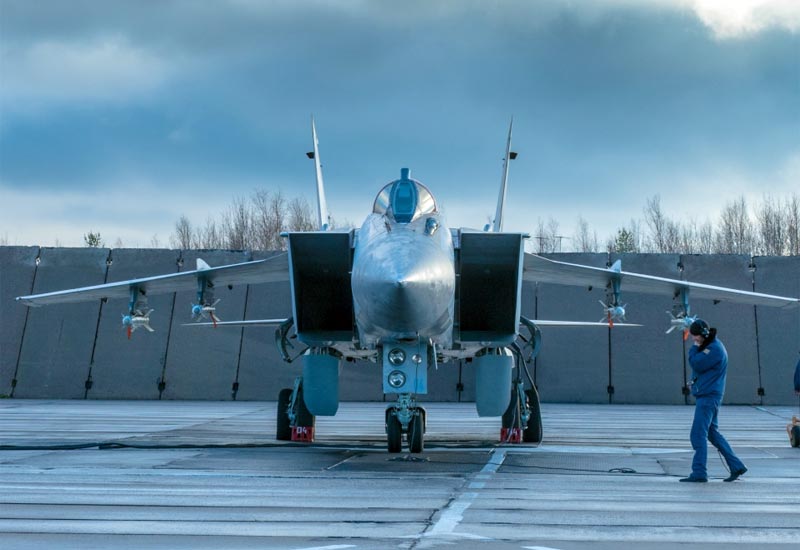
“The best part of the aircraft were the acceleration and the long-range radar. I had been told that aircraft has some very long-range missiles. Also the aircraft had been used to launch satellites. The aircraft had significant weapon carrying capability. However, many modern smaller fighters can carry similar tonnage.”
What was worst about it?
“I think it is not appropriate to call anything ‘worst’. I would hardly call it a fighter aircraft. It was basically a weapons platform in the air. More like an atmospheric satellite, or an airborne cruise ship. I also thought that the aircraft still required more refinements in its avionics, displays and cockpit instrumentation. The WSO station in an Su-30 MKI or Phantom F-4 had an excellent external view, this did not. Essentially designed as an interceptor, one could not call it a fighter in conventional sense. I understand that subsequently, the rear cockpit also got an MFD, otherwise working on the old CRT type round scope was not good for situational awareness and information display. For a Mirage 2000 pilot like me, it was a little confusing initially.”
“Comparing the MiG-31 with Rafale is like comparing Bruce Lee with a Para Special Forces Commando.”
How comfortable is the cockpit?
“I sat in the front cockpit for a few minutes. It was like any Russian cockpit with its green panels and black instrument dials. Having flown the MiG-21, MiG-23BN and MF, and few sorties on the MiG-29 earlier, the cockpit looked very familiar. Some of the instruments were same, others had to change to cover a different range of flight parameters. Two MFDs had been brought in. One could see the cut and paste done to the old cockpit to introduce them. One could make out that more changes were still in the offing. The cockpit was spacious like all Russian aircraft, catering for the well-built and well-clad Ruskies. The ejection seat and strapping was also familiar. One thing I always liked about the Russian cockpits was that there was no need for pilot to wear leg restraining straps, as they were part of the cockpit and seat arrangement. The layout of the throttle, stick and positioning of switches appeared good as per flight usage requirements. This had obviously evolved over the years in all counties. Having interacted very closely with Russian designers, especially the cockpit specialists, in our upgrade project, one knew that they were very knowledgeable and real masters at their job. The rear cockpit was somewhat suffocating and tight. Holding the control column was like holding a round-headed walking stick. The stick could be removed from the base and stowed away. Instrumentation in the rear was awaiting an upgrade. Later pictures of the rear cockpit (on the internet) indicate that the MFDs had been introduced.”
How loud is it for the crew?
“The cockpit was well sealed. After all, the aircraft was meant to fly at very high altitude and at very high speeds. I flew with the normal Russian inner and outer helmet. Same as used on MiG-21. The noise level was reasonably low. Even at high supersonic speed it was quite comfortable and one could converse with other pilot comfortably.”
Why the IAF did not buy the MiG 31?

“Russians had made many attempts to try convince the Indian Government and IAF to go for this “multirole aircraft”. Their main USP was long-range missiles (carrier killer and anti-satellite) and a multi-role platform. India had good experience of the MiG-25, albeit mostly in the reconnaissance role. The IAF well understood the complexities of maintaining an aircraft of this type. The MiG-25 had been bought for high altitude reconnaissance. By now, India had its own satellite based reconnaissance capability. Also more and more UAVs were being used for ISR work. Notwithstanding the upgrade, the MiG-31 remained an old platform inherently designed for high-altitude, high-speed interception. It could not be compared to a modern multi-role aircraft. The IAF had already made up its mind with the Su-30MKI for which the contract was actually signed while we were in Russia. We were also interacting closely with the Indian Su-30MKI upgrade team in Moscow. India was also not keen to put the IAF more into the Russian basket. India had had a great experience with Mirage 2000, and was also looking at adding more upgraded variants of the Mirage 2000. Also India had done its threat perception study. It had seen how its own neighbourhood was evolving. India had no such threat from Pakistan. Yes, India needed long-range missile and interceptors for China. But the same could be achieved by putting a long-range missile on any other aircraft. Having a large radar with long-range was the main advantage with MiG-31 which was not possible on smaller aircraft. But technologies were evolving and later better radar performance was possible from smaller radars. In any case the Su-30MKI had a large area of real-estate in its nose. Interestingly the MiG-31A has been used to launch commercial satellites and MiG-31S have been used to train astronauts, to conduct research in the upper atmosphere and for space tourism by launching the aerospace rally system rocket-powered suborbital glider.

Dear reader,
This site is in danger due to a lack of funding, if you enjoyed this article and wish to donate you may do it here. Your donations keep this going. Thank you.
Follow my vapour trail on Twitter: @Hush_kit
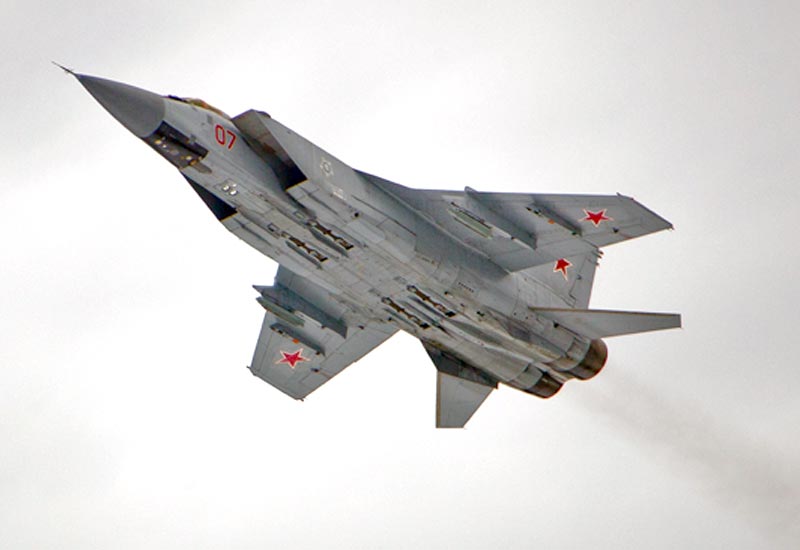
“Not many countries had shown interest in the MiG-31. India also not very sure about the MiG-31’s projected radar capability. Even the Chinese had chosen many Su-30 variants instead of the MiG-31 despite greater potential potency. Unlike the MiG-31, the Su-30 variants manoeuvre very well. The Sukhoi design bureau was also much more aggressive in its marketing. Even a MiG-35 from the Mikoyan stable was considered a better bet, but then India already had plans to upgrade the MiG-29. There was no need immediately for IAF at that time to have an AWACS killer missile. The MiG-31’s capability to launch anti-satellite (ASAT) was not of immediate interest to India. India was already building its own surface based ASAT capability. The IAF’s finite budget allocations could not afford too many platforms. Also buying just 10-12 MiG-31s would have added more logistics complexities to the IAF which already had a plethora of types. As per my knowledge, IAF never did a formal evaluation of the aircraft. The MiG-35 which Russians claim can shoot down almost all kind of reconnaissance drones and other platforms like AEW&Cs and the U-2 spyplane, is one of the contenders of the 114 new fighters India is going to evaluate in the near future.”
What are your feelings on Western versus Russian aircraft – do you have a personal preference and if so, why?
“I have flown a fair number of both Western and Russian aircraft. I have nearly 1,000 hours on MiG-21 variants (MiG-21FL, MiG-21M and MF and MiG-2Bis). I was an instructor on the MiG-21. The MiG was my initial year’s aircraft. I was a pioneer of the Mirage 2000 fleet and commanded a Mirage 2000 squadron, and have around 1200 hours on type. I also happened to have ejected from a Mirage 2000 at the ripe age of 59 years – and two months into the rank of Air Marshal, a sort of record of its own kind. I have also flown the MiG-29, Su-30 MKI, Jaguar and the Hunter, among others.”
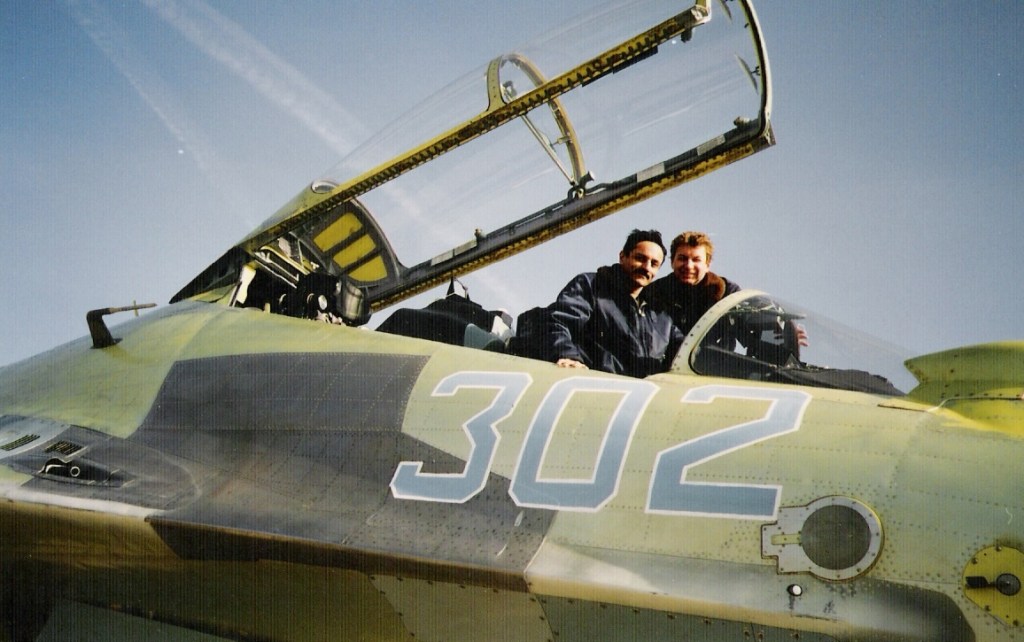
I had earlier done a flight on the Su-27 on 6 December 1991 (my birthday) in Delhi with the famous Russian pilot Viktor Pugachev (of the Cobra manoeuvre fame). I had also flown the Su-30K at Zhukovsky flight test airfield in Moscow with Test Pilot Slava on 13 May 1997. Also flown the under development MiG AT at the same airbase, and the Yak-131D at Sokol. So I have no specific loyalties and can make an independent comment. I had had an occasion to be present at Zhukovsky airfield when the Mikoyan Project 1.44/1.42 aircraft (NATO name: Flatpack) technology demonstrator developed by the Mikoyan design bureau was revealed to the world. Later it had done its maiden flight in February 2000.

Both, the Russian and Western aircraft had their own strengths, weaknesses and idiosyncrasies. Russian aircraft were simpler in design, the cockpits were big, more mechanical than complex electronics, and had high standardisation and commonalty. Switching from one Russian aircraft to other was so much easier. I like the levelling mode of Russian autopilot that brought you to level flight by pressing this button on the control column. This was handy if one got disoriented. I know of someone owes his life to this device. I also liked the simplicity of Russian ejection seats. And they were as foolproof as any Western ones. Russian aircraft mostly had brute power, they were fuel-guzzlers, and some had high specific fuel consumption (SFC), and many passed out smoke through their exhaust. Russian aircraft were cheaper in their base price, but in the long run, their life cycle costs were higher. For example a MiG-29 would overtake a Mirage 2000 in around five years in life cycle costs.

The Western avionics, including electronic warfare systems were more sophisticated. Russians used brute power there too. Russian aircraft required greater stick displacement for any aircraft response, it was much lesser in Western aircraft. This was as per their concept. This had its own dynamics when one changed fleet from Russian to Western aircraft or vice-versa. Pilots had to be cautioned for this. Russian cockpit switches were much larger and easy to operate in the cockpit, the Western were smaller and one had to get used to them while operating with gloves on. The Russian and Western artificial horizon instrument display was quite different. In Russian aircraft the artificial horizon bar turned with the aircraft, thus remained parallel to the aircraft and not to the actual horizon. The aircraft symbol/bar moved twice the degrees to indicate the bank. This worked well when one was head-down. Most pilots really liked this instrument (AGD). In the Head Up Displays of initial Russian aircraft they replicated the same display. This was most confusing because the displayed horizon was different than the real one. We discussed this with the Russian test pilots who had flown some Western aircraft. They also tended to agree with us on this. It took us a great effort and pressure to convince the Russian designers to redo the software to make the MiG-21Bison HUD similar to the Western symbols and logic. Russian designers were not very happy about this. Russian inner helmets were standardised between pilots, tank crew, and even ship or submarine crew. Russian radio navigation system (RSBN) was quite different to the Western TACAN. I found the Russian system very complex and many ways less accurate. The fighter aircraft Air Speed Indicator (ASI) started from 200 km/h, unlike the Western aircraft.
Soviets/Russians remained more than a match for the Western world. They often achieved results with simpler and cheaper means. After all, they were the first to put a man in space and even today are moving ahead with hypersonic weapons. They are being accused by Americans of a cyber-war, so they are still generally demonstrating asymmetrical innovation. There were many more peculiarities of aircraft of both philosophies. Since I have been out of fighter cockpits for some years, I may not remember everything off the top of my head.”
How effective an interceptor do you think it is? How good are the sensors and weapon systems?

“For a successful interceptor, the key attributes are a good radar with long-range detection and tracking, good situational awareness with wider coverage, ability to handle multiple targets, and ECCM features. The MiG-31 radar was indeed powerful and had a good range. I was demonstrated a target at around 185 km range. Also I did see the look-down capability. Beyond that it was difficult for me to comment. In any case the radar and displays would have improved in manifold ways since then. Russian radar and missile combinations have generally done well in some wars including Vietnam and in the Iraq/Iran wars. Though there were other factors for success. Yes, the Americans were able to deceive or jam them with powerful electronic platforms, when they were introduced. Russians believed in brute power in the radar output. Undoubtedly Western avionics are generally better than the Russian ones. Russian missiles are indeed world-class.”
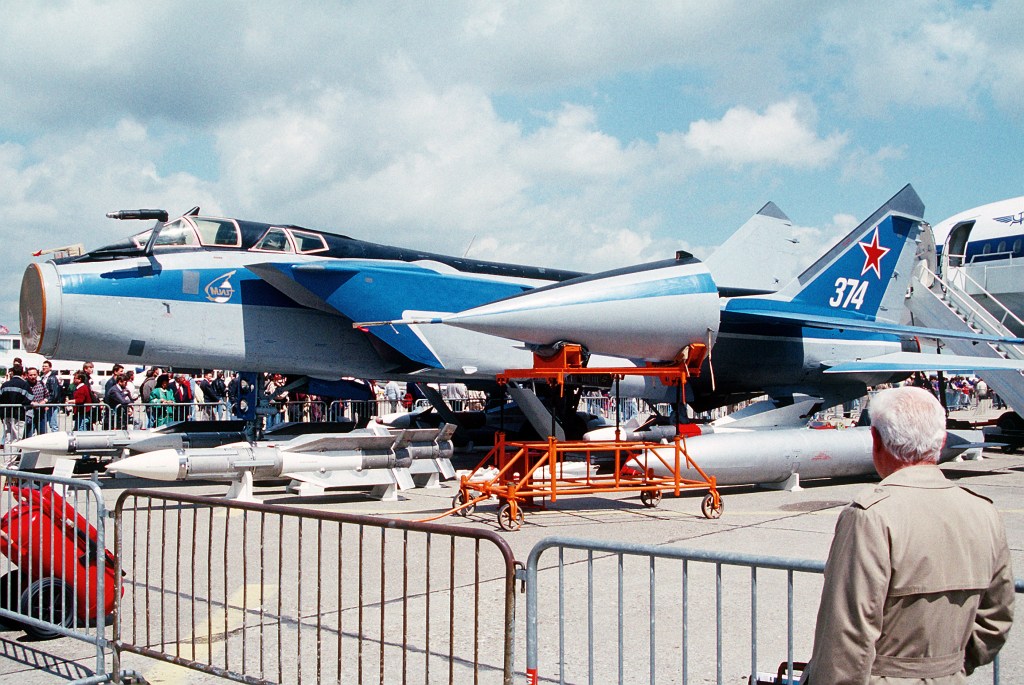
The Hush-Kit Book of Warplanes will feature the finest cuts from Hush-Kit along with exclusive new articles, explosive photography and gorgeous bespoke illustrations. Order The Hush-Kit Book of Warplanes here

Tell me something I don’t know about the MiG-31
“Well, Hush-Kit is an alternative aviation magazine of international repute. There is little that you all do not know and I would know. I am a “ageing foggy aviator”. If I was to summarise my flight, I felt I was sitting atop a missile-head in a high-speed interception. The aircraft looked good and was made of razor sharp nickel steel and other metal edges. I liked the white and blue colour scheme. As someone once wrote, I don’t recall who, that comparing the MiG-31 with Rafale is like comparing Bruce Lee with a Para Special Forces commando. Sure Bruce Lee was much faster with his arms & legs but he couldn’t operate 14 different kinds of guns, run 40 km with a 25 kg backpack, navigate through jungles, perform special recon behind enemy lines, kill anyone just with a kitchen knife & rescue hostages. The MiG-31’s cardinal flaw was lack of versatility, and it is too big and clumsy for use in dogfights. That is how the Sukhoi family of Su-27 variants over took from the Mikoyan designs. The MiG-31 is a formidable machine which had its time.”

Describe the aircraft in three words
“High speed brute.”
How many other Indians have flown the aircraft?
“I am not sure if anyone else has ever flown it. I was told that I was the first foreign pilot. As far as I know, no formal flight evaluation was ever done by IAF. Maybe some team went to have a look at the aircraft and had some formal discussions. But I may be wrong on this score. But India was never interested.”

We don’t need no edgy ejection: Interview with man who ejected from a Harrier and played on a Pink Floyd album

| Neal Wharton was the first pilot to eject from a Harrier, a Red Arrow and the only RAF pilot credited for providing jet noise on a Pink Floyd album. Hush-Kit met him to find out more. |
What were your first impressions of the Harrier? “Amazing, amazing and amazing.”
What was your most memorable Harrier mission…what happened? “An 8hr 25min non-stop flight from RAF Wittering (Cambridgeshire) to Downsview Airport (Toronto) in 1972, for the Canadian International Air Tattoo. Some RAF high-ranker got a bit drunk at a Canadian embassy cocktail party and boasted that he would arrange for two Harriers to take part in this event. It resulted in highly complex planning involving two Harriers supported by three Victor tankers from RAF Marham in Norfolk and two from Gander in Canada to see us into the final stage of the flight. At the time, I was display pilot on No 1 (F) Squadron and was given pretty much carte blanche to present a two-ship display off Lake Shore Boulevard in Toronto. I actually got clearance to do a wheels-up hovering manoeuvre during the display over water (Lake Ontario). This was not generally permitted over land (because a loss of power might still lead to a survivable crash landing whereas over water it would be a straightforward ejection option) but it looked great, particularly when followed by an impressive climbing acceleration with the other Harrier coming in from the opposite direction very low and very fast. The display went down very well and was witnessed by a crowd of over 300,000.
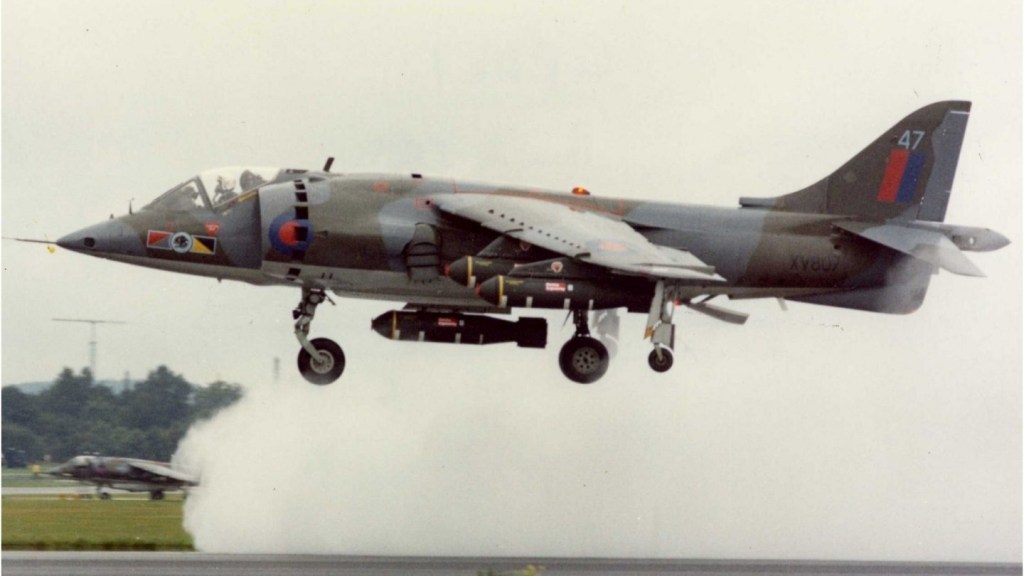
Describe the Harrier in three words: “Outstanding British development.”
What were the best and worst things about the Harrier? “Best thing: Versatility and a joy to fly. Worst thing: A tendency to roll uncontrollably and crash if travelling near the ground at low speed with excessive side-slip. Something to do with intake momentum drag!”
What do you remember of your ejection and the flight which led to it? “I remember my ejection experience as clearly now as when it happened just over 50 years ago (October 1970). This was in the early days of the Harrier and we were operating out of RAF Ouston, a disused World War II airfield near Newcastle, practicing for off-base deployments. I took off, leading a pair of aircraft to carry out a live weapons sortie at Tain Range on the Dornoch Firth in Scotland. We were armed with 28lb practice bombs and 30-mm cannon. The sortie was going normally and after completing our mission we left the range to return to Ouston. I radioed the tower as we approached and they cleared us to make an approach for a conventional landing on the runway. As I was leading, I carried out a circuit at around 1000 ft with my wing man a short distance behind me (he had a good view of the whole thing). I turned onto finals and commenced my approach. At this stage my speed would have been around 170 knots and I would have lowered the landing gear, deployed some flap and rotated the nozzles to reduce speed. As I descended through about 700 ft the engine, without warning, suddenly shut down (or ‘flamed out’ as we would have called it). My initial instinct was to check my fuel state (it wouldn’t have helped but that might have been one explanation for the sudden loss of power) at the same time I operated the relight button on the throttle. The aircraft was now descending more rapidly and I made a quick radio call:
‘Mayday, Mayday, I’ve flamed out, I may have to eject’.
I was still desperately trying to relight the engine to no avail and I was now descending very fast (the Harrier has the gliding performance of a brick, as we used to say) and I can remember very clearly that the trees I was going towards were rapidly getting bigger; I was certain I’d left it too late but I grabbed the ejection seat handle and pulled … “
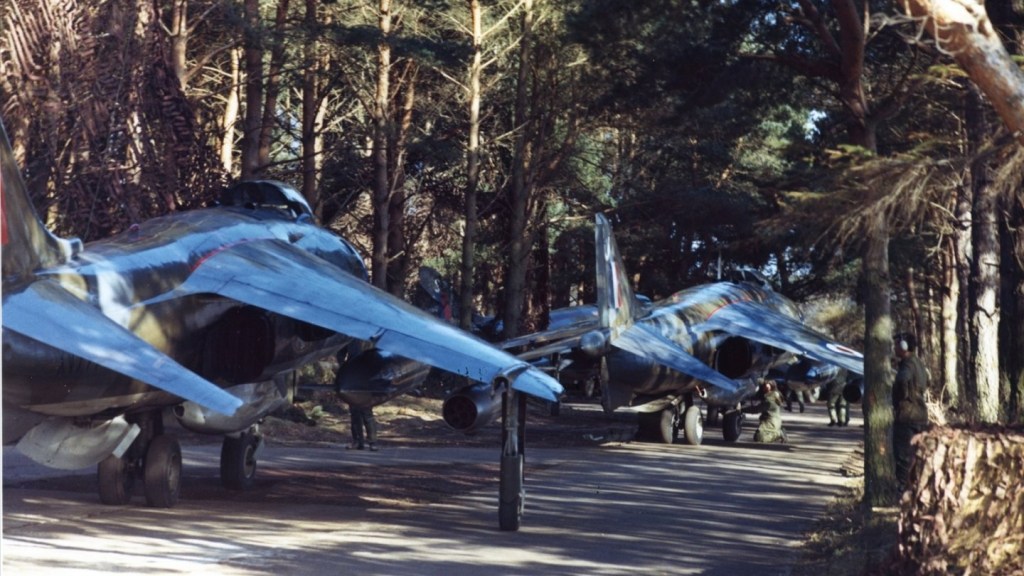
The Harrier has a rocket assisted ejection seat which when activated fires the seat (plus pilot) out of the aircraft with an explosive charge and a split second later the rocket ignites, firing the seat up to a height of 400 feet in less than half a second. Just before the seat leaves the aircraft, a small strip of plastic explosive shatters the cockpit perspex canopy rather than the seat breaking through a solid canopy, which used to happen. I was fortunate in that the aircraft I was flying was almost brand new and was one of only two on the Squadron which had this device.”
Want to see more stories like this: Follow my vapour trail on Twitter: @Hush_kit

Preorder your copy today here.
The solid well-researched information about aeroplanes is brilliantly combined with an irreverent attitude and real insight into the dangerous romantic world of combat aircraft.
The book will be a stunning object: an essential addition to the library of anyone with even a passing interest in the high-flying world of warplanes, and featuring first-rate photography and a wealth of new world-class illustrations.
Sadly, this site will pause operations if it does not hit its funding targets. If you’ve enjoyed an article you can donate here and keep this aviation site going. Many thanks

“. . . . my immediate memory on pulling the handle was a huge kick in the backside as the seat was banged out of the aircraft. At the same time I was aware of going up through something like confetti, but which was, in fact, hundreds of pieces of perspex as the canopy exploded. I was now aware of tumbling through the air until suddenly it stopped, as the drogue chute deployed to stabilise the seat before pulling out the main parachute. At this stage I remember looking upwards (which was in fact downwards as I was now inverted) and saw a huge swathe of orange fire as the Harrier struck the ground. (I had been in that aeroplane approximately one second earlier!) I didn’t bother to look up and check whether the parachute had deployed properly (as most people tend to do) because I suddenly realised that I was going to survive, which is a feeling quite difficult to describe. I didn’t have long in the chute but I managed to unclip and lower my personal survival pack (PSP) which contains, among other things, your dinghy – useful if ejecting over water. I hit the ground hard, going backwards and with a wind gusting to 30knots… the sort of conditions which might well have caused a broken leg but not if you were as relaxed as me – I was alive!
I lay on the ground, cautiously examining arms and legs to see if they were still there and was pleased to see that all seemed well and that the chute had collapsed on landing rather than dragging me along the ground in the strong wind. I stood up, unbuckled myself from the chute, and surveyed the scene. I was in a large grassy field with my aircraft blazing furiously a hundred feet or so away, belching out black smoke into the autumn sky. The metal skin round the cockpit was white hot. A lady, the farmer’s wife I discovered later, was cautiously approaching. Her face was ashen and she was very shaken. As she got close to where I was standing she managed to ask, in a quavering voice, ‘Would you like a cup of tea?”
Epilogue:
The engine failure was found to have been due to a worn bearing in the engine driven gear box which powered the main fuel pump. I ejected at about 100ft and the aircraft hit the ground 1.1 seconds later. I received minor neck injuries due to whiplash during the initial part of the ejection sequence but I was flying again two weeks later. I never did get that cup of tea but I did sink quite a few beers with the guys when I got back from the hospital!”
What was your collaboration with Pink Floyd? “Yes, that was me on their album ‘The Final Cut’. It referred to some sound effects that I helped with, using a Hawk and a very low pass at 480 kts!”
Special thanks to Phil Rowles & Martin Baker
Eurofighter Typhoon versus Dassault Rafale video: Part 1
Top 14 Flying Machine Restaurants
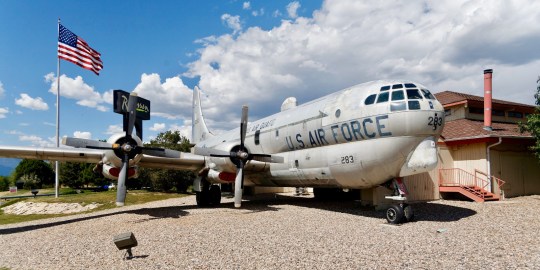
Flying and dining, will our relationship to these things ever be fully restored? While we’re waiting for the pandemic to abate, let’s whet our appetites by fondly recalling some of the finest gourmet flying machines in the world. Remember your table manners and pack the Pepto Bismol as we chart, and order, a course for the heights of aero-culinary culture. Some of these places are long gone. A couple of them are truly happy instances of aeronautical conservation, even if they are going to be off limits for a bit longer. For others, well, pass the salt. As with everything else in this life, all is temporary, kids. Stephen Caulfield is out to lunch.
- The Airplane Cafe, Los Angeles, California, USA

Considering some of the monstrosities produced in the first decades of aviation this plywood box could easily be mistaken for an actual aircraft in 1927. Best feature is the light bulb poking out of each cylinder of that radial engine. Cute for sure and with an aspirational gap between the ground and the ‘fuselage’ representing flight. Sadly, even the exact location of The Airplane Cafe is no longer remembered.
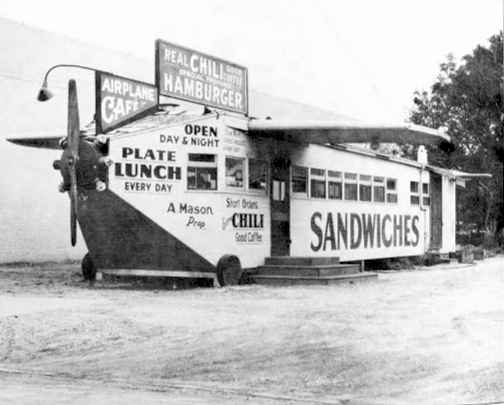
Cockpit access: no.
First date prospects: likelihood of success estimated to be high.
- Zep Diner, Los Angeles, California, USA

A brick-and-mortar tribute to the airships of the 1920s and 1930s. How gracefully the Zep Diner glides onto this top list. Picture yourself in Howard Hughes’ Italian loafers walking up those front steps in a natty double-breasted suit. An adoring Hollywood star or starlet on your arm. You both might have ordered well-done Hinden Burgers from the menu. Rather aptly destroyed in a gas main explosion in 1999, the Zep Diner is sorely missed by three generations of Angelenos. Her old corner at Figueroa Blvd and West Florence Ave today hosts only the usual drive-up dreck North Americans have endured for the last hundred years.
Cockpit access: not applicable.
First date prospects: fantastically high likelihood of success associated with the Zep in newspaper accounts and contemporary diaries.
Attention span too short for reading? Subscribe to our YouTube channel here.
- Space Shuttle Cafe, New York City, New York, USA

Aviation history is social and cultural history as well. Can this mash-up of a city bus and a Douglas DC-3 be a depressing metaphor for the decline of a once serious nation and its global hegemony? Is it up for sale online every couple of years? Yes, both.
Cockpit access: driver only.
First date prospects: looks shaky, all depends.
- Douglas DC-3, Taupo, New Zealand

Before 1945 it was a quirky world of independent, owner-operated aero-dining establishments. While rich in character and diversity that world was eventually replaced by a handful of all-powerful chains. This ex-Australian Airways DC-3 bridges both worlds. Some day this airframe will be a five star opportunity for restoration and museum display. One day we will even see it flying again. We feel that in our bones. And in our lower intestines.
Cockpit access: yes.
First date prospects: low-to-moderate likelihood of success expected.
- Flying Saucer Restaurant, Niagara Falls, Ontario, Canada
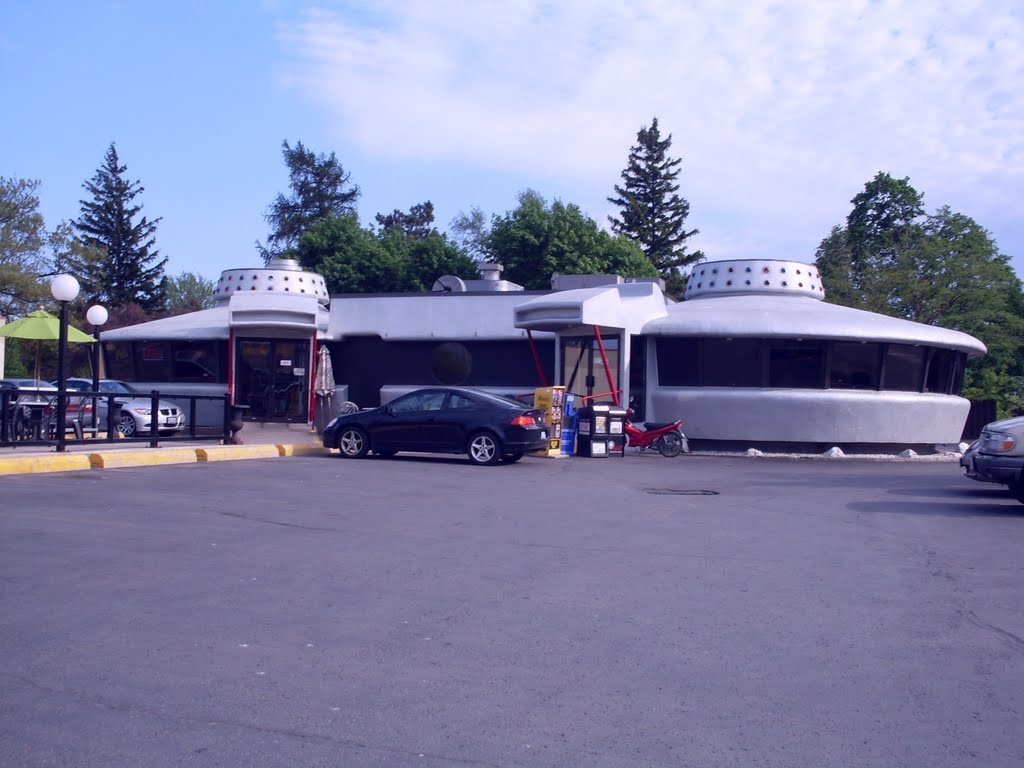
Eye-catching roadside novelty buildings were features of the great heyday of North American consumerism and automobile tourist culture. Aviation and later space travel themes abounded in built structures from the 1930s into the 1970s. The Unidentified Flying Object also entered the popular culture and architecture starting with the Foo Fighters of the 1940s and the flying saucers of the 1950s. A few tired survivors of that era still dot the continent’s biways, stubbornly holding onto the better times. Those were romantic and prosperous days built on hard work, cigarettes, depression, cheap gas and coronary-artery disease. Oh Canada, if only they could have lasted forever.
Cockpit access: not applicable.
First date prospects: very good (especially by local standards).
- DC-6 Diner, Douglas DC-6, Coventry Airport, UK

A handsome vintage airliner from less viral times. A time of optimism and rapid economic growth. A great place for a Lysander Chicken Pot Pie a generation later. This conversion is apparently part of a minor pre-lockdown boom in aeroplane restaurants in the UK. It serves up a brace of meaty dishes that are, wait for it, named after aeroplanes. The UK’s beef-loving geeks and spotters also have a destination now in Lancashire. Post Covid-19 this trend will hopefully grow and grow. Imagine brunching with your love interest in the back of a retired Antonov An-225 Mriya next Valentine’s Day without a mask in sight.
Cockpit access: yes.
First date prospects: moderate-to-high expectations of success.
- Lockheed L-1049G Super Constellation, Toronto, Ontario, Canada
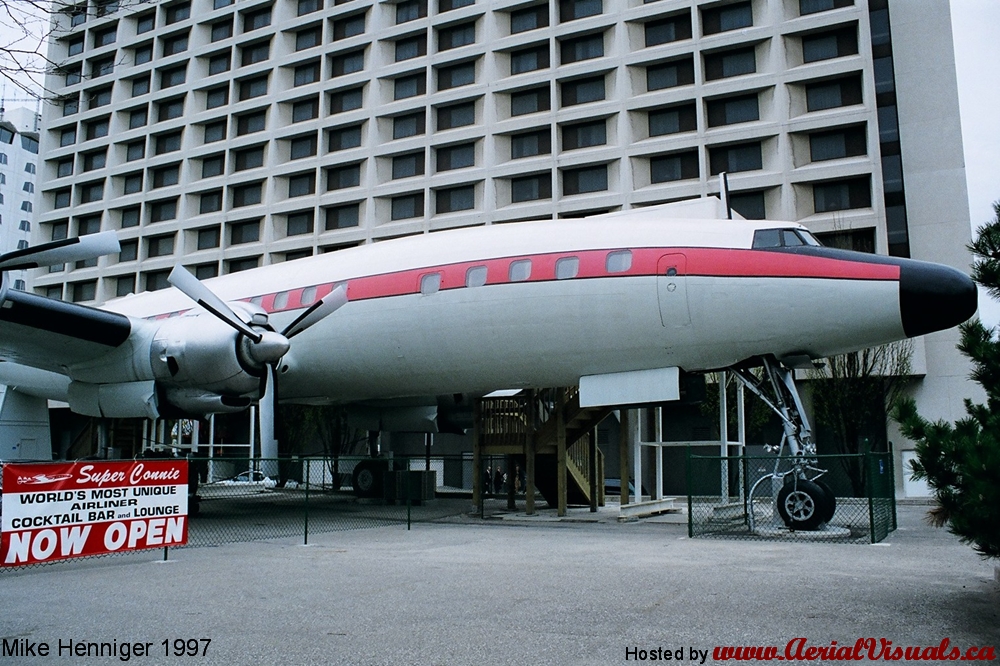
Aeroplane bars and restaurants are often accessories to hotels. So it was at Toronto’s Regal Constellation, briefly the largest convention and hotel site in Canada’s business capital. The Globe and Mail looked back in 2011 and said that it ”…was once the hippest hotel in town, with the city’s coolest cats sipping martinis on giant red leather couches while conventioneers from across North America rubbed shoulders in its Arabian Nights-themed bar.” Plunking an ex-Trans Canada Airlines Super Constellation down in the parking lot as a cocktail bar was a 1980s attempt to reenergise the hotel’s fading mid-century glory. Ahead of its time perhaps. The full lust for such things would have to wait for the age of Mad Men. Toronto’s blazing commercial real estate market refuses to tolerate anything but high intensity usage of property between the downtown core and the airport. The ageing hotel buildings were demolished. Luckily, the Constellation was restored for static display. It reposes with the dignity befitting such a beautiful machine.
Cockpit access: yes.
First date prospects: universal reports of absolutely massive success.
- The Airplane Restaurant, Boeing KC-97, Colorado Springs, Colorado, USA

How spoiled we were before the lockdown. So many choices. Eating outside the home tempted us daily. In equal measure, familiarity, quality and tastiness brought us out in the first place. The setting and atmosphere inside our favourite establishments kept us coming back. Local foodies and tourists with an enthusiasm for Cold War airplanes loved to sit where the A-1 jet fuel tankage used to be. Advanced reservations and big lineups were a small price to pay to see this rare 1950s bird based on the Boeing B-29 Superfortress. No smoking within 500 feet, please.
Cockpit access: yes.
First date prospects: moderately successful on most days after 11:00 am.
- LaTante DC 10 Restaurant, McDonnell-Douglas DC-10, Airport City, Accra, Ghana
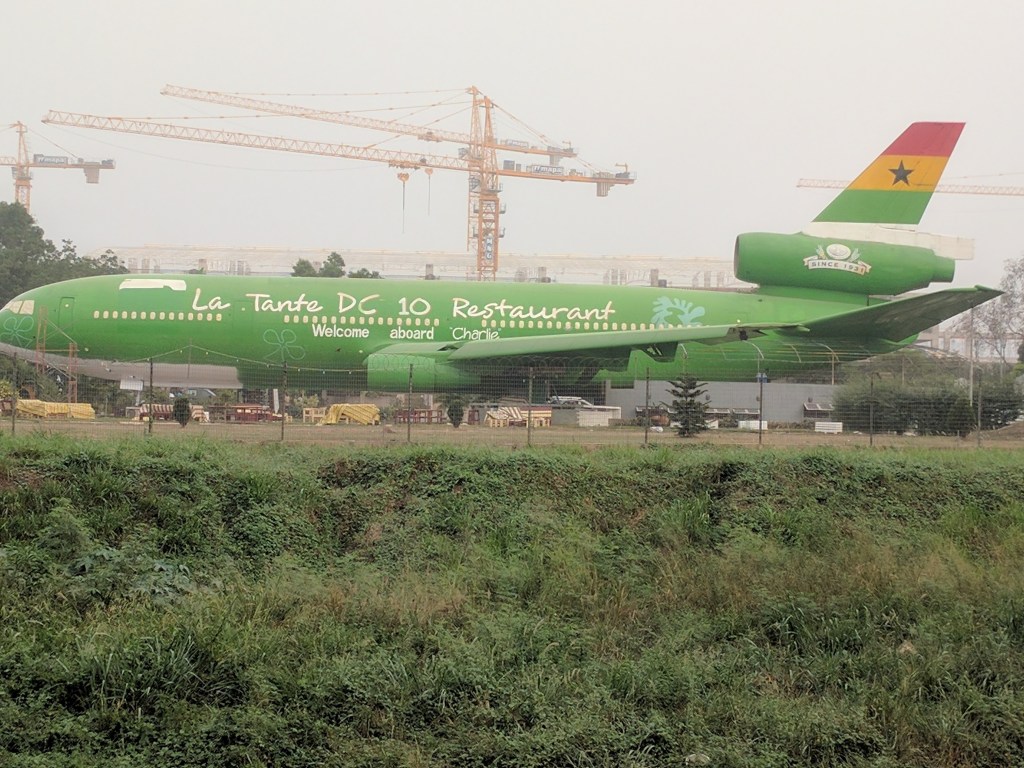
A happy retirement for one example of a good design that never escaped notoriety for a series of crashes early its career. Indeed, a joyfulness surrounds this conversion of a wide-bodied, trimotor airliner from the early 1970s.

Regional dishes pique one’s curiosity about this cheerful-looking establishment. Would we rather pass the time here or in any post-9/11 airport terminal anywhere on the face of the Earth? Yes, and we’ll have the fish.

Cockpit access: yes (with virtual reality feature!).
First date prospects: enormously high.
Here’s a new thing! An exclusive Hush-Kit newsletter delivered straight to your inbox. Hot aviation gossip, opinion, warplane technology updates, madcap history and other insights from the world of aviation by @Hush_Kit Sign up here:
- Lily Airways, Boeing 737, Wuhan, People’s Republic of China
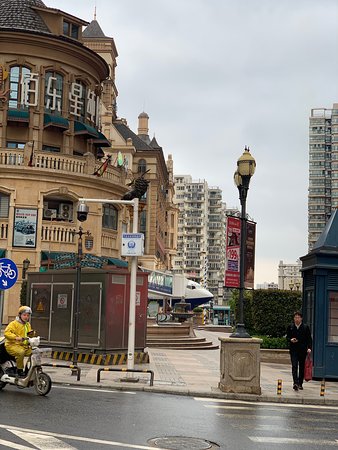
Airplane-to-restaurant conversions can be interpreted as artefacts of peak economic power. No less than three airliner conversions from the high-growth cities of Asia have made it to this list. The Optics Valley New Technology Development Zone in Wuhan checks in with this fine-dining showpiece. Your table is reached by an airport-style loading bridge connecting to a large commercial development done up in the style of a small European capital city in the nineteenth century. Avoid the bat sushi buffet.*
*Editor: you’re doing that joke, seriously?
Cockpit access: yes.
First date prospects: data is controversial but expectations cautiously positive.
Want to see more stories like this: Follow my vapour trail on Twitter: @Hush_kit

Preorder your copy today here.
The solid well-researched information about aeroplanes is brilliantly combined with an irreverent attitude and real insight into the dangerous romantic world of combat aircraft.
The book will be a stunning object: an essential addition to the library of anyone with even a passing interest in the high-flying world of warplanes, and featuring first-rate photography and a wealth of new world-class illustrations.
Sadly, this site will pause operations if it does not hit its funding targets. If you’ve enjoyed an article you can donate here and keep this aviation site going. Many thanks
- Boeing 737-400, Keramas Aero Park, Malaysia

The 737 remains one of the most successful aircraft of all time. It was the DC-3 of its day and so restaurant conversion is a natural second career for them. The 737 is small enough not to be excessive and they are common in the airliner aftermarket. Tuck in to your Nasi Lemak like it was 1970 all over again!

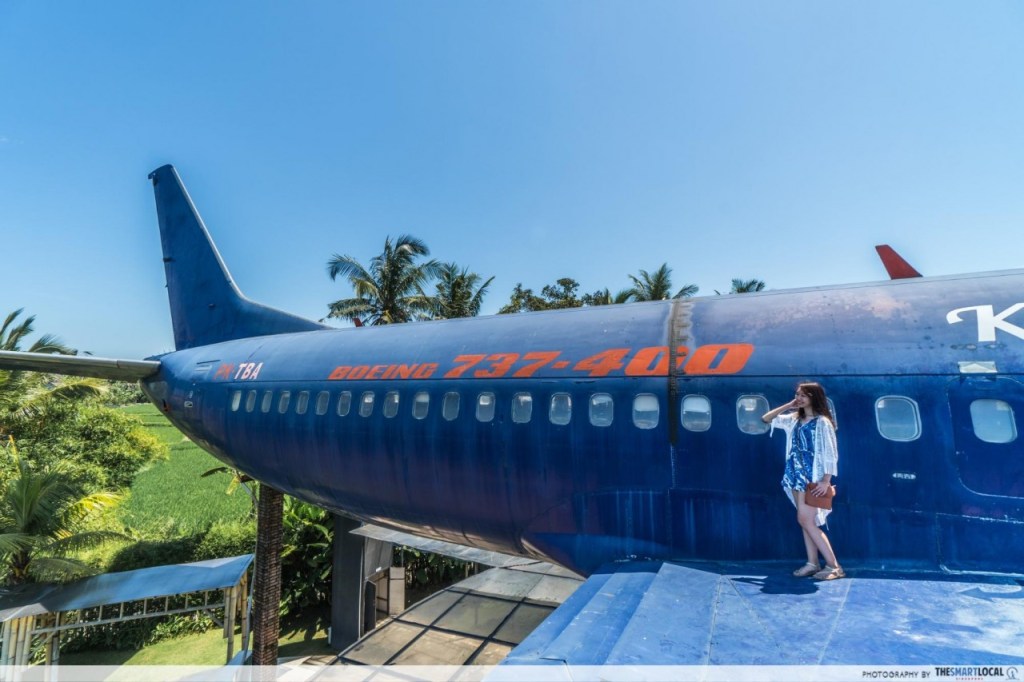
Cockpit access: yes.
First date prospects: moderate-to-good levels of success expected.
- Runway 1. Airbus A310, Rohin Adventure Island, Delhi, India

Fasten your eat belt, people. Shahi paneer, aloo ghobi, palak paneer with pilau rice and coriander naan: that is what we would stuff our faces with if we went here. Then we’d stroll out on that port wing deck with a water view for a drink or six. Wide-bodied airliners offer serious opportunities for restaurant conversion. They have proper entrys and exit points, reasonable head room and extra compartments for modern HVAC and safety equipment, washrooms and so forth. Pass the samosas.
Cockpit access: yes.
First date prospects: always strong.
- Grill-Avia, Sud-Ouest SO-30 Bretagne, Amberieu-en-Bugey, France

Some things shouldn’t need explaining. This twin Bretagne could have probably flown if it hadn’t been destroyed by a blaze that began in the starboard grease trap during this one totally crazy New Year’s Eve party. What a way to ring in 1989!
Cockpit access: two for the price of one.
First date prospects: good-to-outstanding level of success guaranteed.
- Lockheed Super Constellation, TWA Hotel, JFK Airport, New York, USA
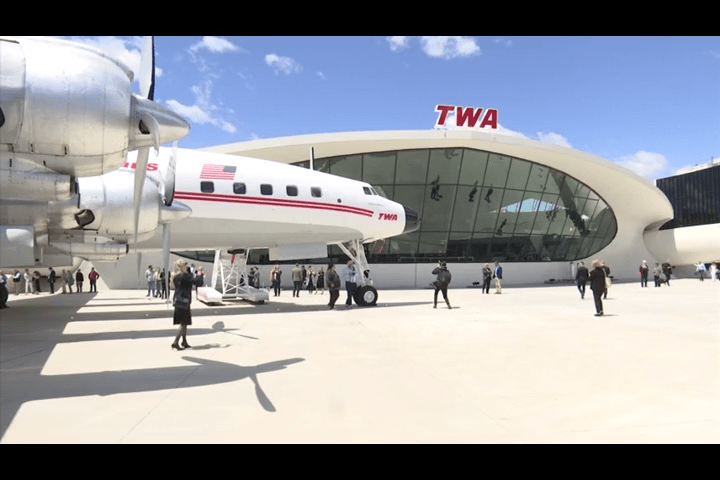
Has there ever been a better time to live in the past? Now your retro escape to the near past when the future was still something to welcome can be taken to boutique levels. Right in the grounds of the original mid-century Aerotropolis itself. Constellation conversions seem to have made sense over the years given the size and initial supply of them at low cost when jetliners were taking over. Few other objects say ‘cool’ and mean it as much today as they did sixty-five years ago quite like a Constellation does. Small wonder this model of airliner makes a double appearance here and has at least nineteen cocktails we know of named after it.
Cockpit access: yes.
First date prospects: honey, it’s never ever gonna get any better than this.
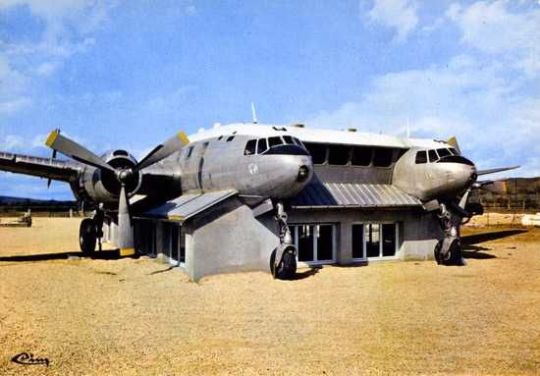
Fleet Air Arm Myth #5 Taranto inspired Pearl Harbor

The Japanese have taken many Western concepts and improved on them. Trains, home electronics, and vending machines for used underwear are just some of the items that spring to mind. [1] Popular opinion in the author’s twitter feed is that this includes raids on harbours by carrier air power. The logical line being drawn that the attack by the Fleet Air Arm on Taranto on 11 November 1940 inspired the 6 December 1941 attack on Pearl Harbor by the Imperial Japanese Navy Air Service.

The Royal Navy had been considering how to attack a fleet in harbour for the two decades preceding the Second World War, after the frustrating experience of only having one go at the German High Seas Fleet in the First when they refused to come out for a second round after the Battle of Jutland. They’d also carried out the first carrier-based air raid on 19 July 1918 on the airship base at Tondern. [2] Putting the two ideas together was in fact on the to-do list when the armistice got in the way.

The Taranto raid was no spur of the moment thing, planning for an attack had started in 1935 onboard HMS Glorious during the Abyssinian Crisis and was updated and rehearsed in Malta during the Munich Crisis of 1938. RN intelligence had established the depth of the nets surrounding the Italian battleships and it was determined that they’d allow a torpedo to pass underneath. The trick would be stopping them hitting the 40’ deep seabed, achieved by attaching a wire to the front. They wouldn’t hit the hull but handily the British had developed the Duplex torpedo pistol that was set off by the magnetic influence of the ship passing overhead. Or not, which is helpful if you’re HMS Sheffield being attacked by Swordfish that have mistaken you for Bismarck. In the week preceding the raid multiple convoys were routed across the Mediterranean while the Fulmars from Ark Royal and Illustrious ensured no Italian aircraft observed the latter’s task group approaching Taranto. [3] Consequently, the raid came as a complete surprise to the Italians who’d thought they knew where all the RN’s ships were, and that they’d see any naval attack coming. Despite this contrary to stereotypes of Italian martial prowess their anti-aircraft guns were manned and managed to down two of the 21 attackers, as close as you can get to the 10% losses predicted in 1938. In exchange the RN had put 3 battleships on the harbour bottom, although as it was fairly shallow two were back in service within a year, the third still being worked on when Italy surrendered in 1943. The fleet was also moved to Naples to make any further attacks more challenging. Although Taranto briefly altered the balance of power in the Mediterranean and gave the RN more freedom of manoeuvre it would still be contested until 1943, being the biggest navy in the world only gets you so far when you’re also the busiest.
Pearl Harbor clearly had a lot of similarities, a hidden approach to ensure the attack was a surprise, torpedoes used in waters previously thought to be too shallow, [4] and most of the sunk ships re-entering the war. Another similarity was the gestation period of the idea. War games at the Japanese Navy War College had modelled a carrier strike on Pearl Harbor in 1927, with a lecture on the subject by one Captain Yamamoto the next year. Fast forward to April 1940 and now Admiral Yamamoto was discussing a raid on Pearl Harbor with the Chief of Staff of the Combined Fleet. Which unless Yamamoto also had access to a time machine means it was impossible for him to have been inspired by Taranto as it hadn’t happened yet.
It is true Japanese naval officers had visited Italy in June of 1941 and one of the 83 topics they discussed with the Regina Marina was the raid on Taranto. [5] However, as the First Air Fleet under Captain Genda started detailed planning for attacking Pearl Harbor in April of that year even this would have provided limited value.
At best then Taranto may have given the IJN some encouragement that their plan could work, but the plan itself was an entirely Japanese concept. Like Kabuki theatre, or convincing Gaijin you can buy used underwear from a vending machine.
[1] The last isn’t a complete urban myth. Yes, yes I did research this. https://www.techinasia.com/japan-used-panty-vending-machines-fact-fiction
[2] Regrettably by this stage the RAF had been formed so were also involved although the majority of the personnel involved had previously been in the RNAS.
[3] This also disproves myth 5b that the RN didn’t use deck parks until operating with the USN in the Pacific. With Eagle out of action Illustrious had to use one to carry the extra Swordfish along with her usual compliment of aircraft. As did any of her class that carried Sea Hurricanes, because making folding wings is hard.
[4] Unless you were the US observer onboard Illustrious during Taranto who spent a frustrating 13 months trying to convince the USN it was possible. Still at least he got to say ‘I told you so’.
[5] 83 is a precise number but the Italians appear to have kept notes. https://www.usni.org/magazines/naval-history-magazine/2016/december/taranto-pearl-harbor-connection
Bing Chandler is a former Lynx Observer and current Wildcat Air Safety Officer. If you want a Sea Vixen t-shirt he can fix you up.
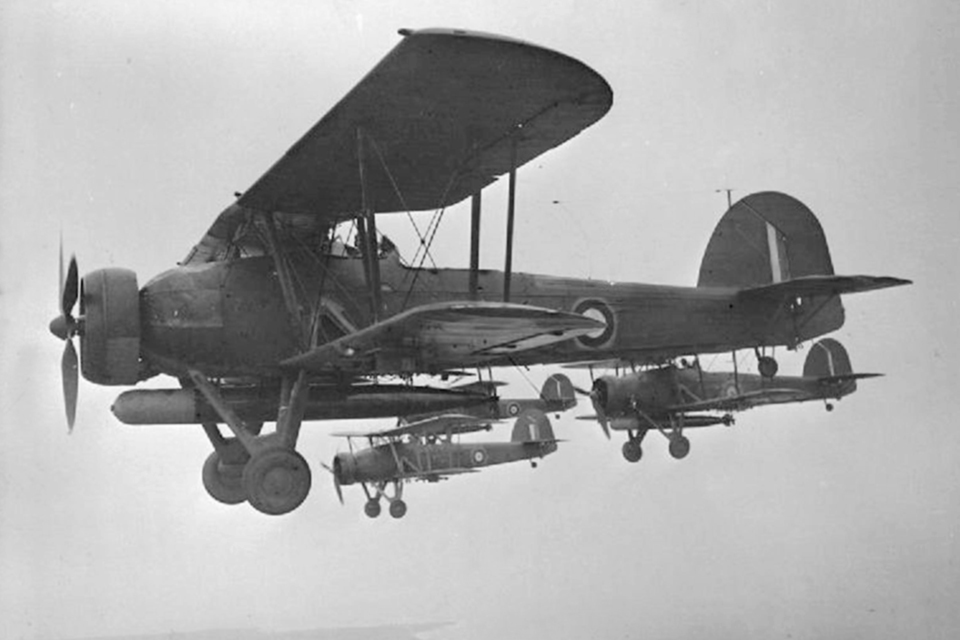
11 warplanes that stopped killing and started helping

I’ve heard it said that you have to be a little bit mad to take an interest in military aircraft. As much as the more conscientious of us might try to ignore their intended functions, the fact remains that these are machines designed and built to kill people and break stuff.
But we can take solace in the fact that not all is so macabre about the technological wonders over which we salivate. Here are ten warplanes that beat their swords into ploughshares, renouncing their martial lives—even if only fleetingly—for decidedly more humane ones.
11. Lockheed C-130 Hercules ‘The Herky Farmer’
If averting a localised ecological disaster seems a contradictory task for a military aircraft, how about a role that could potentially help to combat the climate crisis?
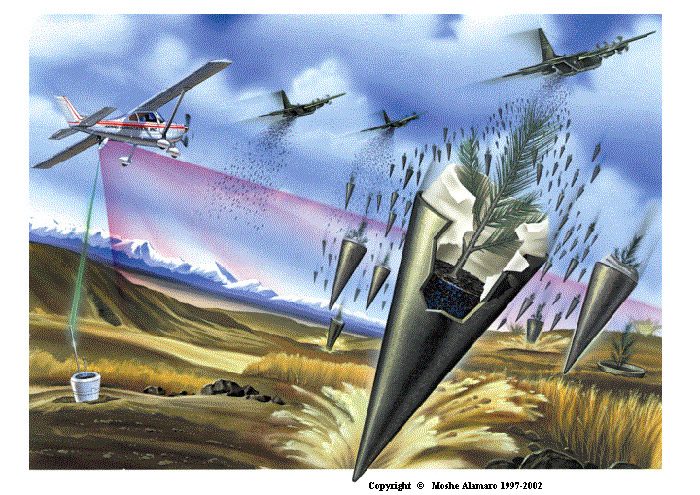
The C-130 Hercules is best known as a madly successful tactical transport, that also happens to excel at almost every noncombat role its operators can think of; the proverbial jack of all trades, master of…all of them, really. It’s also got some serious teeth, whether as the AC-130 gunship or the MC-130 special operations variants used among other things as the launch platform for the GBU-43/B MOAB (Massive Ordnance Air Blast, a.k.a. Mother of All Bombs).
But the heroic Herc has also been used to drop decidedly more life-giving stores. Seed bombing—or, more diplomatically, aerial reforestation—has been around since the 1930s, but came into its own when a former RAF pilot, Jack Walters, came up with an idea to convert equipment used for laying landmines for dropping seed canisters. The concept, which now consists of placing a seed, fertilizer, and insecticide inside a biodegradable capsule that looks a bit like the bastard lovechild of a household plant pot and a howitzer shell, was adopted by Lockheed Martin. New technology like GPS, high-resolution cameras (sometimes attached to remotely piloted airships), and timed ejection devices not unlike the ones used by the likes of RAF Tornado fighter-bombers to crater runways during the Gulf War has made the method extremely efficient and cost-effective. Seed bombing has been used in places like Africa, Haiti, Scotland, and Mexico.
10. McDonnell Douglas F-4 Phantom II ‘Phantom Organ’

The F-4 Phantom II is best known for wreaking devastation from Southeast Asia to the Middle East, for being the tip of NATO’s spear at the height of the Cold War, and for generally being an obnoxiously noisy, smoky, brutish behemoth of a multirole fighter. But, just a few days before Christmas in 1986, one USAF pilot used his Phantom not to take a life but to save one.
The passing of four-month-old Michael McCann in North Dakota was certainly a heart-wrenching tragedy for the poor child’s family, but his death would not be in vain, as his heart was resuscitated and packed onto a Learjet with a team of doctors at Fargo’s Hector International Airport to be flown to San Francisco, where a five-month-old boy, Andrew de la Pena, desperately awaited a transplant. But disaster had seemingly struck when the Learjet’s engines failed to start in the cold weather. Time and options were running out. So, North Dakota’s governor put in a call to the Air National Guard.
Within minutes, an F-4D of the ND ANG’s 178th Fighter-Interceptor Squadron, the “Happy Hooligans,” who happened to be based at Hector, was scrambled. Because the F-4 was intended to be pretty much the polar opposite of an air ambulance, its cockpit isn’t climate controlled, so the organ—which had been out of the donor body at least eight hours, an eternity relative to the medical technology of the time—was placed in an ice-filled plastic cooler and strapped into the Phantom’s back seat, then flown by then Lieutenant (now Brigadier General) Bob Becklund the 1,446 miles (2,327 km) from North Dakota to California at just below supersonic speeds. De la Pena, who seems to be living a quite remarkable life, still has a special place in his heart (pun somewhat intended) for Becklund and the Air National Guard.
As for the Phantom, it promptly resumed its decidedly less humanitarian duties, which, in the case of the Happy Hooligans, primarily involved air defense of the North American continent. This instance wasn’t the only occurrence of a fast jet being used to carry an organ transplant; I’m sure I read that the Royal Norwegian Air Force did something similar with an F-16, but I can’t find the article.
9. Polikarpov Po-2 ‘Night witch of the harvest’

One of the ten most widely produced aircraft in history, this seemingly unassuming biplane had always lived a double life. Sometimes known as the U-2 (“U” for uchebnyy, “trainer”), to be confused with neither the American spy plane nor the disappointing Irish rock band, the sturdy and brilliantly uncomplicated Polikarpov’s value extended far beyond training pilots. The type was used for light bombing, reconnaissance, liaison, and propaganda duties, as well as psychological warfare, where Soviet pilots would fly low over German encampments using their mount’s five-cylinder Shvetsov M-11 engine, with its stentorian popping sound, to deprive their enemies of sleep and fray their nerves with simulated bombing runs. The Luftwaffe found engaging the biplanes particularly difficult, as they flew at treetop level and too slow for the German fighters to manoeuvre into position on. The all-female 588th Night Bomber Regiment used the Po-2 to great effect against the German rearguard. It would see service again in the Korean War, where it was used in night raids on UN bases, which the Americans came to call ‘Bedcheck Charlie.’ The Po-2’s wooden construction gave it an (relatively) infinitesimal radar cross section, rendering it almost immune to night fighters, and its slow speed earned it at least one ‘kill’ when an F-94 Starfire stalled and crashed trying to shoot one down.
But this was just one persona. The other, known as Kukuruznik, was, as its nickname (which translates roughly as ‘corn-sprayer’) suggests, a crop duster. The ethics surrounding the Soviet Union’s agricultural programmes and practices are dubious at best—this is the state, after all, that managed to dry up the Aral Sea—but the harvests were in good hands (wings?) for whoever the state decided was worthy of providing for, with variants of the Po-2 able to deliver up to 250 kg of pesticides. The Po-2 was also built under license in Poland and used as an air ambulance.
8. Avro Shackleton ‘The contra-rotating Nissen hut’
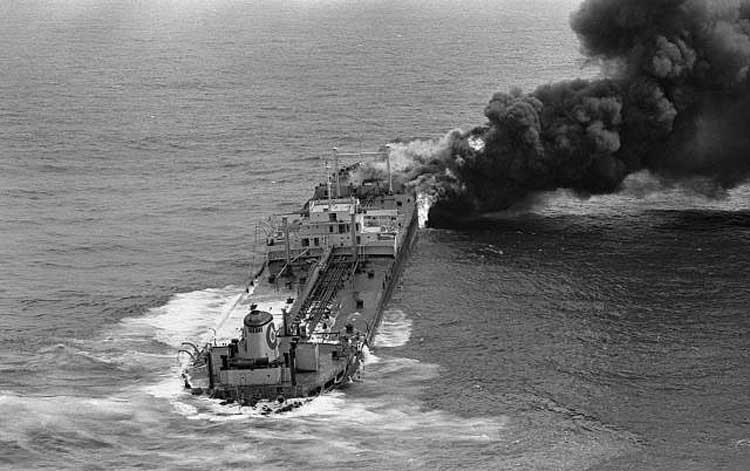
Aircraft are usually associated more with environmental degradation than environmental protection, but on one rather controversial occasion in 1971, the Avro Shackleton was credited with averting an ecological catastrophe.
The South African Air Force was the sole export customer for the Shackleton maritime patrol bomber, with 35 Squadron acquiring eight MR3 variants beginning in 1957 to replace the Short Sunderland. Fourteen years after its introduction, a SAAF Shack found itself called upon to deploy its armament—not against Soviet submarines, but an oil tanker. On 27 February of that year, the SS Wafra suffered a steam turbine failure while en route to Cape Town, causing the engine room to flood. An attempt was made to tow the stricken vessel into port, but the tow cable snapped, and Wafra ran aground on a reef near Cape Agulhas, rupturing eight of the tanks and spilling at least 26,000 tons of crude oil (some accounts say far more), swamping beaches and polluting a penguin colony.
While efforts were made to mitigate the extent of the spill, the ship itself remained on the reef, still leaking oil. The decision was made to sink the vessel before any more damage could be done. In early March, Wafra was refloated and towed off the reef, where she promptly broke apart. The larger portion was towed 200 miles out to sea (leaking oil all the way), at which time the SAAF was called into action. First on scene were Buccaneer strike bombers of 24 Squadron, which fired AS-30L laser-guided air-to-ground missiles at the hulk, succeeding only in starting a fire. (If only they’d taken note of the British debacle following their similar attempt four years earlier in the disaster of the tanker Torrey Canyon.)
Clearly, a change in tactics was needed. On 12 March, the SAAF deployed its Shackletons, dropping a total of nine depth charges on the tanker, which quickly broke apart in 6,000 feet of water, a depth where the remaining oil would pose no further threat to the coastline.

Like the F-4, the Shackleton went right back to its military duties, but for that moment, it got to play the saviour to human, avian, and marine life alike.
7. Curtiss C-46 Commando ‘Ol’ Dumbo to the rescue’

I was going to try to avoid listing transport aircraft, as cargo haulers don’t (usually) participate directly in the killing, and almost every transport type has been used in some form of humanitarian role such as disaster relief. But the vital work that the C-46—once the poster child for flying the ‘Hump’ in the China-Burma-India Theatre of World War II—continues to perform in the far north makes it worthy of a mention.
Transportation in the northern reaches of North America is a logistical nightmare. Road infrastructure is spartan at best, and frozen ports and rivers preclude seaborne shipments in some places for large portions of the year. Aviation isn’t just a luxury—it’s many communities’ lifeblood. The C-46, together with former war veterans such as the C-47, C-54, and C-118, flies with operators like Buffalo Airways in Canada and Everts Air in Alaska to deliver much needed supplies and especially fuel, providing a year-round link for isolated communities.
6. Bell AH-1 Cobra ‘Snakes on a plain’

It’s no rarity for military helicopters to have second lives in the civilian sector. Types ranging from the Bell Huey (and its myriad variants) to the Boeing Chinook and Mil Mi-8 have been employed in tasks like construction, logging, passenger carrying, search and rescue, policing, and giving television watchers an eagle-eyed view of the latest horrible event in their hometown on the evening news.
You’ll note that none of those aircraft are attack helicopters, which are generally designed with a singular, macabre purpose in mind. But with the right creativity, even these killing machines can be repurposed for the good of humankind. In the early 2000s, the U.S. Forest Service acquired a number of Army-surplus AH-1Fs, ditching the guns and hardpoints for additional cameras and sensors, creating the Firewatch Cobra. While the USFS Firewatch aircraft don’t directly fight fires, a handful of surplus AH-1Ps acquired by the Florida Department of Forestry and renamed Bell 209 Firesnake are equipped to carry water and retardant systems. Instead, the Firewatch Cobra is used to relay information to ground crews and fixed-wing air tankers to facilitate a more accurate and effective attack. Its infrared sensors can detect flames through heavy smoke, and it can transmit high-resolution images of the fire from its low-light cameras to ground teams up to thirty miles away.
5. Rockwell OV-10 Bronco ‘Broncosaurus Flex’

Apropos of aerial firefighting, the Bronco, better known as the slower, uglier, more American Pucará, is essentially the fixed-wing version of the aforementioned Cobra. The California Department of Forestry and Fire Protection—CAL FIRE—acquired a number of these former counterinsurgency aircraft to replace the O-2 Skymaster to provide airborne command and control, a set of eyes in the sky for the incident commander on the ground. Crewed by a pilot and an air tactical group supervisor, the Bronco provides a manoeuvrable platform with excellent cockpit visibility for observing a fire’s dynamics and directing fixed- and rotary-wing tanker assets.
4. Airco DH.4 ‘A letter from the flaming coffin‘

The end of World War I saw a flood of surplus military aircraft into the civilian market, many of them finding new lives carrying mail. Airmail was one of the earliest large-scale non-military applications of aircraft; after all, in an era long before email and robocalls and social media, the fastest way to get your spam to fools in other parts of the world was to stick it in a stamped envelope and send it on its way. Then, just as today, speed was a priority, and as such, companies such as United Airlines, today one of the largest air carriers in the world, got their start hauling letters and parcels.
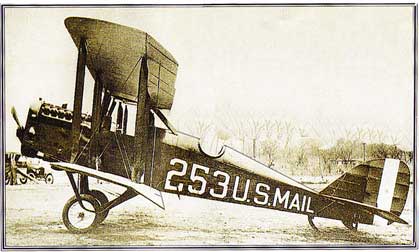
Several ex-Army types were employed on mail runs and limited passenger-carrying services, but Geoffrey de Havilland’s light bomber stands out, finding success on mail runs on both sides of the world, with Qantas and the U.S. Post Office making extensive use of the aircraft, the latter modifying it into the DH.4B variant with an enlarged rudder. The DH.4B was used to establish the first transcontinental airmail service in North America, between San Francisco and New York, operating from 1924 until the privatization of airmail in 1927. The DH.4 also saw extensive postwar use in Canada, where it was used for forestry patrol.
3. Avro Lancaster ‘Lanc-danke’
There’s an old Japanese proverb that ends with “the sword that kills is the sword that gives life.” While in its full context that statement refers to something entirely different, taken in isolation, it’s a fitting aphorism for the role of the Lancaster over Berlin: the bomber that once rained death and destruction down on the city would be aiding in the effort to keep its citizens alive just a few short years later.
During the Berlin Airlift of 1948-49, the Allies scrambled to scrounge together as many aircraft as they could to maintain the air bridge into besieged Berlin. While the C-54 Skymaster and C-47 Skytrain are the aircraft everyone thinks of when they hear Berlin Airlift, a number of types were called upon to carry rations to the city’s inhabitants, the Lancaster bomber (together with the Lancastrian, an airliner and transport derived from the Lanc) among them. One can only imagine the thoughts going through the head of any Berliner with a knack for aircraft identification, seeing the aircraft that had been used to raze vast swathes of their city now bringing in the goods to rebuild it.
Want to see more stories like this: Follow my vapour trail on Twitter: @Hush_kit

Preorder your copy today here.
The Hush-Kit Book of Warplanes is a beautifully designed, highly visual, collection of the best articles from the fascinating world of military aviation, hand-picked from the highly acclaimed Hush-Kit online magazine (and mixed with a heavy punch of new exclusive material)


This site will pause operations if it does not hit its funding targets. If you’ve enjoyed an article you can donate here and keep this aviation site going. Many thanks
2. Lockheed P-2 Neptune ‘The Truculent Fire Turtle’

Large ex-military aircraft often find retirement jobs fighting wildfires—those air tankers that the Cobra and Bronco we talked about get to guide to their targets. Former naval types such as the PBY Catalina, CS2F Tracker, AF-2S Guardian, and PB4Y Privateer have been particularly attractive for this role. The P2V (later P-2) Neptune had arguably the most successful career of them all, with its 2,000-gallon water/retardant capacity and the power boost from its underwing J34 turbojets that came in handy when operating at low level in mountainous terrain.
The Neptune’s potential as an air tanker was realized in the late 1980s, and it flew with numerous operators including Aero Union, Minden Air, and the aptly named Neptune Aviation. Air tanker P-2s featured a sophisticated (for the time) digital metering system featuring computer-controlled, electro-hydraulically actuated doors for a continuous water or retardant release from 50 to 700 US gallons per second, allowing for a uniform dispersal pattern eliminating gaps or overages.
Alas, aerial firefighting is no walk in the park, and at least nine tankers were destroyed in accidents over the type’s thirty-year firefighting career, with several more experiencing landing gear failures toward the end of its service life. A high-profile crash in 2012 precipitated the end of the Neptune in air tanker service, and the last user, Neptune Aviation, retired theirs in 2017, replacing them with modified BAe 146s.
1. Lockheed P-3 Orion ‘Friggerock ‘n’ Roll’

Not to be outdone by its predecessor, the P-3 Orion continues to perform sterling work nearly sixty years after it entered service. From dubious roots in the troubled L-188 Electra airliner, the Orion has evolved into an aircraft that, in addition to being one of the most successful maritime patrol aircraft in history, has been indispensable in ancillary roles like long range search and rescue, fisheries patrol, and ice monitoring. And that’s just the ones still in military service.
Like the Neptune before it, some Orions were converted into air tankers. But putting the wet stuff on the red stuff isn’t all the P-3 has been up to in its new life. NASA’s Goddard Space Flight Center operates a P-3B from its Wallops Flight Facility in coastal Virginia as an aerial science laboratory. But perhaps the best-known civvie Orions are the WP-3Ds of the National Oceanic and Atmospheric Administration (NOAA)—the Hurricane Hunters. Together with some USAF WC-130Js, these aircraft and their crews brave some of the most treacherous weather on earth to acquire real-time storm data to save countless lives.
-Sean Kelly is an operations supervisor at Pittsburgh International Airport who spends most of the time he isn’t being paid to do things related to aircraft doing things related to aircraft (and occasionally writing science fiction).

Who was the first supersonic man? Former F-15C pilot takes a dive into supersonic tails of the unexpected

The great test pilot Chuck Yeager, the first supersonic pilot, passed away this week. Former F-15C pilot Paul Woodford takes this opportunity to break some popular sound barrier myths – and take a tail-ward look at supersonic aircraft.
A couple of weeks ago I posted a photo of Jacqueline Cochran to my Facebook page, along with a note explaining that she was the first woman to break the sound barrier when she flew an F-86 Sabre past the Mach in 1953. A friend posted this comment:
You should add “in level flight”. Lots of WWII fighter pilots broke the sound barrier in combat dives, many died because they did not understand why their controls suddenly became useless.
I responded with this:
There’s a certain amount of mythology about WWII-era prop fighters exceeding the speed of sound in dives. Not known to have ever happened. The control problems some pilots reported happened in transonic flight as shock waves built up around the airplane and the elevators lost authority (which is why supersonic aircraft have all-moving horizontal stabilizers today). The F-86 Cochrane flew was a hopped up Canadian built version with a big engine, and in fact she had to dive to hit the Mach … the F-86 couldn’t go supersonic in level flight.”

I want to flesh out my response, mostly by way of rumour control. First of all, let me stress my lack of aeronautical engineering credentials. I’m an English major. There’s a lot I don’t understand about the mechanics of transonic and supersonic flight. What I do know is what I was taught in flight school, and what I experienced in my years flying supersonic trainers and fighters. If I screw up some of the principles and technical language, I hope you’ll forgive me, but I think I’m qualified to address some of the apocryphal tales handed down from generation to generation, and to provide a simplified overview of transonic & supersonic flight and the changes to aircraft flight controls necessary to achieve it.
World War II and prop fighters
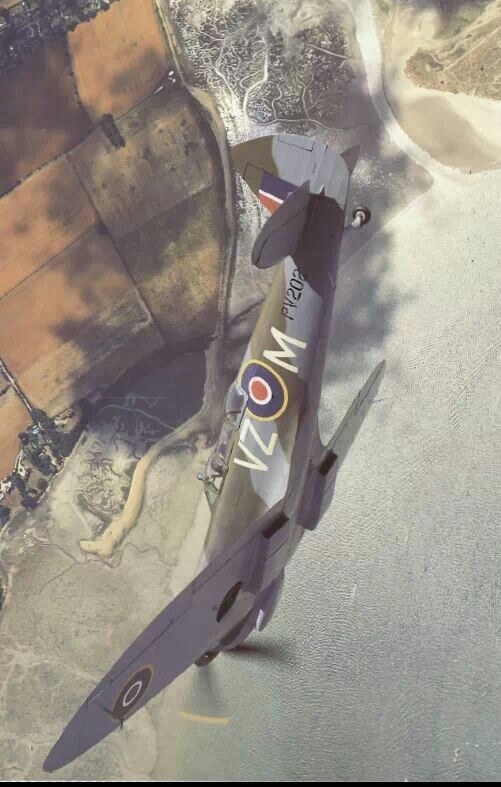
At the pinnacle of prop fighter development, aircraft like the Lockheed P-38 Lightning and Supermarine Spitfire could attain transonic speeds in steep dives. The transonic range is generally considered to be between Mach 0.8 and 1.0 (600 to 768 mph at sea level), but since mph numbers go down as you climb into thinner air and lower temperatures they’re not really meaningful, so from now on I’ll only talk Mach numbers. Even if we had at the time understood supersonic flight and knew how to build the thin wings and area-ruled fuselages needed for supersonic flight, compressibility would have still made it impossible to force the big disc of a spinning propeller much beyond Mach 0.9.
In one test flight, a Spitfire managed to hit Mach 0.92 in a 45-degree dive, at which point the propeller and reduction gear left for parts unknown. The test pilot was lucky to survive. Other pilot reports from the time stated that it was extremely difficult to recover from transonic dives. Some pilots described the problem as “control reversal” but that’s not what it was (no one ever had to push forward on the stick to recover from a dive). Control problems resulted from a combination of two factors: one, the physical force required to move the stick aft in a transonic dive was enormous; two, the aircraft’s ailerons and elevators were rendered ineffective by transonic shockwaves forming around the wings and tailplanes. In other words, it was extremely difficult to move the stick in the first place, and when the pilot was able to move it, the ailerons and elevators couldn’t “bite” enough air to control aircraft attitude. The only way to safely recover from a transonic dive was to throttle back to idle and let aerodynamic drag slow the aircraft to a speed at which control effectiveness was regained. Some WWII prop fighters (the P-38 Lightning, for example) actually had speedbrakes that auto-deployed in high speed dives, precisely to keep pilots out of this “coffin corner.”

Early jet & rocket fighters
There are unconfirmed stories of Luftwaffe pilots reaching the Mach in the German Me 262, the first jet fighter. Some claim German test pilots went supersonic in prototype rocket-propelled fighters. The stories about the Me 262 breaking the sound barrier, even in a dive, are almost certainly mistaken. The Me 262’s fuselage design and fat wings would be considered incompatible with supersonic flight today. Cockpit airspeed indications sometimes jump around in transonic flight as shock waves form near the pitot tube, and this may have led some pilots to believe they’d exceeded the Mach. The secret weapon rocket planes may well have done it, but if it happened it was never documented.
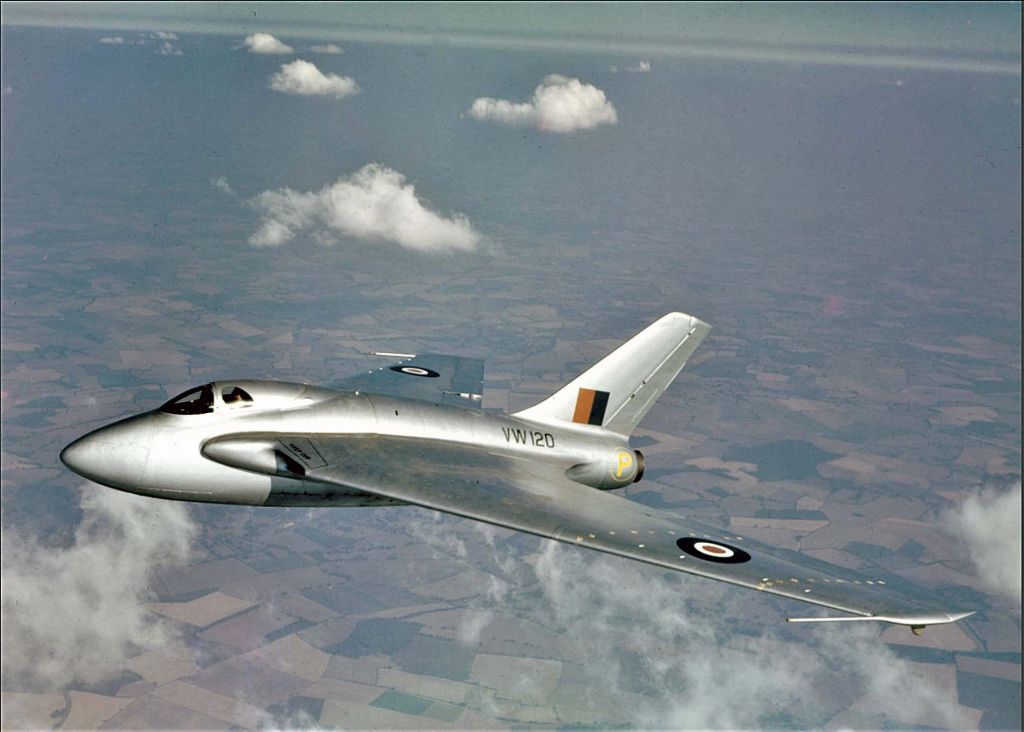
Some still believe that in 1946, British test pilot Geoffrey de Havilland, Jr. exceeded the speed of sound in an early jet, the de Havilland DH.108 ‘Swallow’, but then encountered control reversal and died in the ensuing crash. Actually, transonic shock waves caused the Swallow’s wings to flutter during a transonic dive and they broke off. That’s what killed Geoffrey de Havilland, but the incident helped create the myth that the speed of sound was an actual ‘barrier’.
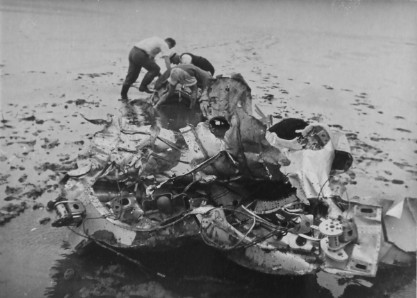
On October 14, 1947, USAF pilot Chuck Yeager achieved true supersonic flight in the rocket-powered Bell X-1 (the design of which, apparently, was originally British*). A few days earlier another USAF pilot had gone supersonic in an XP-86 Sabre, but he did it in a dive and his speed wasn’t officially confirmed or recorded, so, as with the Luftwaffe rocket pilots, his achievement didn’t count. Yeager’s speed run was measured and recorded, and he did it in level flight to boot, and that’s the flight that’s in the history books.

*Editor note: this is a controversial claim, see Miles M.52 story.
I want to go back to flight controls now, the real subject of this post. World War II prop fighters and most early jet fighters had conventional flight controls. The stick and rudder pedals were directly connected to the ailerons, rudder, and elevators by rods, cables, and pulleys. The elevators, which control pitch, were hinged surfaces on the rear of the horizontal tail. When you got into a transonic dive, it became physically difficult to move the elevators, and even when you did, they didn’t have enough authority to bring the nose up and break the dive. In the early jet days, when aircraft like the F-86 Sabre and MiG-15 could get well into the transonic region in level flight, you had the same problems plus a shock wave effect called Mach tuck, which forced your nose down and put you into a dive. You didn’t have enough elevator authority to overcome Mach tuck and stay level. The Soviet MiG-15 had auto-speedbrakes that deployed at Mach 0.92 to keep pilots from exceeding that speed.

McDonnell F2H-2P Banshee

Conventional horizontal stabilizer with hinged elevator and trim tab on an F2H-2P Banshee (photo: Paul Woodford)
Aircraft designers had been aware of transonic flight control problems from the early days of WWII and had tried several approaches to overcome it. The answer proved to be hydraulically-actuated flight controls and an all-moving tail. With hydraulic assist, pilots no longer had to physically overcome the enormous airflow pressures on their elevators and ailerons. Ditching the hinged elevators and going to all-moving horizontal stabilators gave fast jets enough pitch control to maintain level flight or pull out of a dive as the aircraft began to generate transonic shock waves (side note: once you’re past the Mach the shock wave is behind your aircraft, and a simple hinged elevator would be more than enough to control pitch at supersonic speed … you need the all-moving tail to maintain control as you move through the Mach).
A potential problem with hydraulically-actuated flight controls was that the pilot wouldn’t be able to feel the actual force of the air on the external flight controls. Without that feel, it would be easy to over-control an aircraft at transonic speeds, potentially to the point of ripping the tail off. The solution was to add “artificial feel” to the stick, with the force required to move it increasing it as aircraft speed increased (but nowhere near the force that would be required to move the stick with conventional flight control systems).
The F-86 Sabre, America’s first swept-wing fighter, had hydraulically-actuated flight controls and artificial feel. They say one of the factors that gave our F-86 pilots an edge over the Russian, Chinese, and North Korean MiG-15 pilots they flew against during the Korean War was that our jets weren’t physically exhausting to fly. The MiG, with conventional muscle-powered flight controls, took a lot out of its pilots at speeds above Mach 0.8; moreover, it was dangerously uncontrollable above Mach 0.92 (hence the auto-speedbrakes that kept it from flying faster). In addition to hydraulic assist, later models of the F-86 had all-moving tails. Our guys didn’t have to worry about flying too fast because they could maintain control at all speeds. The MiG bubbas had to constantly watch their speed lest they fly into an uncontrollable flight regime.
The F-86 Sabre is what drew me into this discussion in the first place. When I read that Jacqueline Cochran broke the sound barrier in an F-86, my first thought was “no way” … the Sabre wasn’t supersonic. It had relatively thin wings, but the fuselage wasn’t area ruled, it didn’t have an afterburner, and it was slower than the subsonic MiG-15s it faced in combat in Korea. But as I looked into the subject, it became apparent that the F-86, along with most early swept-wing fighters, could bust the Mach in a dive, and in fact that’s how Jackie did it. The jet she flew was a Canadair Sabre with all-moving horizontal stabilators. As mentioned above, while the first Sabres had conventional tails with hinged elevators, the F-86E and later models had all-moving horizontal stabs.

All-moving horizontal stabilator on an F-86L (photo: Paul Woodford)
What did I do next? I took photos of the tail sections of two late-model F-86 Sabres on display at the Pima Air & Space Museum, where I’m a volunteer docent. The F-86L, had the single-piece all-moving horizontal stabs I expected to see, but the F-86H sitting next to it appeared to have conventional horizontal stabilizers with hinged elevators, and that I did not expect to see. The F-86H was the last, and hottest, F-86 model built, and according to everything I’d read it was supposed to have all-moving horizontal stabs. Here’s what I saw when I looked at the F-86H.
North American F-86H Sabre

Certainly looks conventional, doesn’t it? I started asking around, hoping one of the other volunteers might know someone who had flown Sabres. Two weeks later, my tree-shaking paid off: I heard from a pilot who’d flown every model of the F-86. Here’s what he said:
The F-86A had conventional tail controls: a fixed stabilizer with an attached moveable elevator which was moved either by the pilot’s control stick or by an electric trim motor. This design proved to be largely ineffective in the supersonic regime (above .9 Mach) where recovery from a supersonic dive required very large angles of elevator movement which exerted so much stress that it sometimes caused rivets to pop out from the trailing edge. Pilots complained that the flight controls appeared to be “strange” in the transonic speed range. They seemed to be “reversed” — if the pilot wanted to pull up and his speed was near Mach 1, the aircraft continued to go down. The controls did not actually reverse, they simply did not respond effectively.
The F-86E tail was called an “all-flying tail”. The F-86E’s elevators and horizontal stabilizer operated as one unit. The horizontal stabilizer was pivoted at its rear spar so that the leading edge was moved eight degrees up or down by the normal action of the control stick. The elevator was mechanically linked to the stabilizer and moved in a specific relation to the stabilizer movement, with the elevator travel being slighter greater than stabilizer travel. This effectively created a larger elevator surface — as the pilot called for more elevator, the stabilizer would move in conjunction with the elevator, creating a greater angle of attack, thus giving better control at all speeds. The all-flying tail of the F-86E eliminated many of the undesirable compressibility effects that were characteristic of the F-86A. It made recovery from a sonic dive much more straightforward, with much less danger of structural damage or catastrophic failure. Externally, the only difference between and F-86A and E was the presence of a bulge in the fuselage of the E immediately in front of the stabilizer to cover the gearing mechanism.
The picture … of your F-86H shows it to have the same all-flying tail as was on the E and F models. It would work in the same manner as I have described above.
All-moving horizontal stabilators are standard equipment on supersonic fighters and trainers today. You’ll also see all-moving stabilators on many airliners, which cruise in the Mach 0.8-0.9 regime. On modern fighters, the stabilators work differentially to control roll as well as pitch. Here are the stabs on the fighter I flew, the F-15 Eagle:
McDonnell-Douglas F-15A

What you don’t see very often is an all-moving vertical tail. Yaw isn’t a big deal in transonic flight, not like pitch, so a conventional hinged rudder on a fixed vertical tailplane works well. The F-15, if you stomped in full right or left rudder, gave you 30 degrees of deflection. Above Mach 1.5, however, a mechanical limiter kicked in and you could only move the rudders 5 degrees. This was one of the things I had to check during the supersonic portion of functional check flights, and I always fed in rudder slowly, visions of snapped off vertical tails prompting caution. Nevertheless a few supersonic aircraft had all-moving vertical tails, presumably with limiters similar to those on the F-15. A few I can think of off-hand were the SR-71, XB-70, F-107, and the A-5 Vigilante:

The forces acting on an aircraft and its flight control surfaces at transonic speeds are enormous. Flying at those speeds in early jet fighters was a much bigger deal than it is today, and I can’t tell you what it was like. I can tell you what it’s like in an F-15 Eagle, though.
The first few times I went through the Mach I wasn’t attuned to my environment, but the more experience I gained the more I could sense my speed through the feel of the aircraft. When the Eagle got up to around Mach 0.95 you’d begin to feel resistance, as if the air was getting thicker and pushing back against your airplane. As you slipped past the shockwave and through the Mach the resistance went away and the airplane felt normal again. The second you retarded the throttles, though, it was as though you’d run into an invisible Stay-Puft Marshmallow Man in the air. You and your jet and everything in it slowed down in a hurry, forcing you forward against the shoulder straps and seat belt. Once you were back below Mach 0.95, Mr. Stay-Puft went away and things felt normal again. Oh, and half your fuel was gone.
No one asked, but my personal speed record is Mach 2.21, achieved in a clean F-15C on a functional check flight over the North Sea. On paper the Eagle is capable of Mach 2.5, but I’ve never heard of anyone reaching that speed.
Want to see more stories like this: Follow my vapour trail on Twitter: @Hush_kit

Preorder your copy today here.
From the cocaine, blood and flying scarves of World War One dogfighting to the dark arts of modern air combat, here is an enthralling ode to these brutally exciting killing machines.
The Hush-Kit Book of Warplanes is a beautifully designed, highly visual, collection of the best articles from the fascinating world of military aviation –hand-picked from the highly acclaimed Hush-kit online magazine (and mixed with a heavy punch of new exclusive material).
“the thinking-man’s Top Gear… but for planes”.
The solid well-researched information about aeroplanes is brilliantly combined with an irreverent attitude and real insight into the dangerous romantic world of combat aircraft.


Sadly, this site will pause operations if it does not hit its funding targets. If you’ve enjoyed an article you can donate here and keep this aviation site going. Many thanks
I’m only going to say this once, not because you, dear reader, don’t know it, but you’d be surprised how often people ask me, and who knows, one of them may read this some day: yes, you can hear yourself talk when you’re supersonic; no, you can’t hear the sonic boom.
Well, that was a whole bunch of nerdy tl;dr, all generated by a comment to a one-paragraph Facebook post commemorating Jackie Cochran’s supersonic flight in 1953. I know I’m leaving a lot out, but I wanted to hit the important parts. Next time you hear people telling tall tales about supersonic Mustangs and Thunderbolts, their brave pilots heroically overcoming every natural instinct in the face of control reversal, perhaps you can point them my way. Or at least pass on the link to this post.
We strongly recommend you check out blog’s excellent blog

The time US bombers attacked a live volcano

The interwar period was a time of revolutionary change in military aviation, the great advances in engines, materials and engineering lead many air forces to test out just what fighters and bombers could and couldn’t do. They might be able to render battleships vulnerable to land- and carrier-based aircraft, but they couldn’t tame volcanoes – as the US Army Air Corps found out in 1935.
The largest island in the Hawaiian chain, Hawai’i, has three active volcanoes, two of which erupted in the 20th century. In 1935 Mauna Loa became active, with its flows threatening the Hilo area, the largest city on the island and agricultural centre of the islands at that time.
While explosives had been tried on Italian lava flows going back to the 1660s, the US Army Air Corps, Hawaii Volcano Observatory and Corps of Engineers thought massed explosives on the ground might make the eruption worse, so they decided to bomb it from the air to divert the lava’s path. The director of the Hawai’i Volcano Observatory, Thomas A. Jaggar had long considered well placed high explosives to be a potential “solution” to lava flows and gas vents endangering populated and economically important areas. So when the 1935 flows started moving towards Hilo, he was the primary advocate for using Army assets in an experiment. His boss didn’t think it’d work, the Army crews didn’t think it would work and the bombs would just bounce off the ground. But the mission went ahead. On December 27, 1935, ten Keystone B-3 and B-4 bombers from Luke Field on Ford Island in the middle of Pearl Harbor flew the 200-odd miles to bomb the Humu‘ula lava flow. The bombers dropped 40 bombs, half were high explosive and the rest were WP smoke bombs to mark the impact points. Of the twenty high explosive bombs dropped, sixteen hit the target area and twelve hit the lava tunnel in question. For bombing during this era, that is quite accurate, hitting the broadside of a mountain and all that.

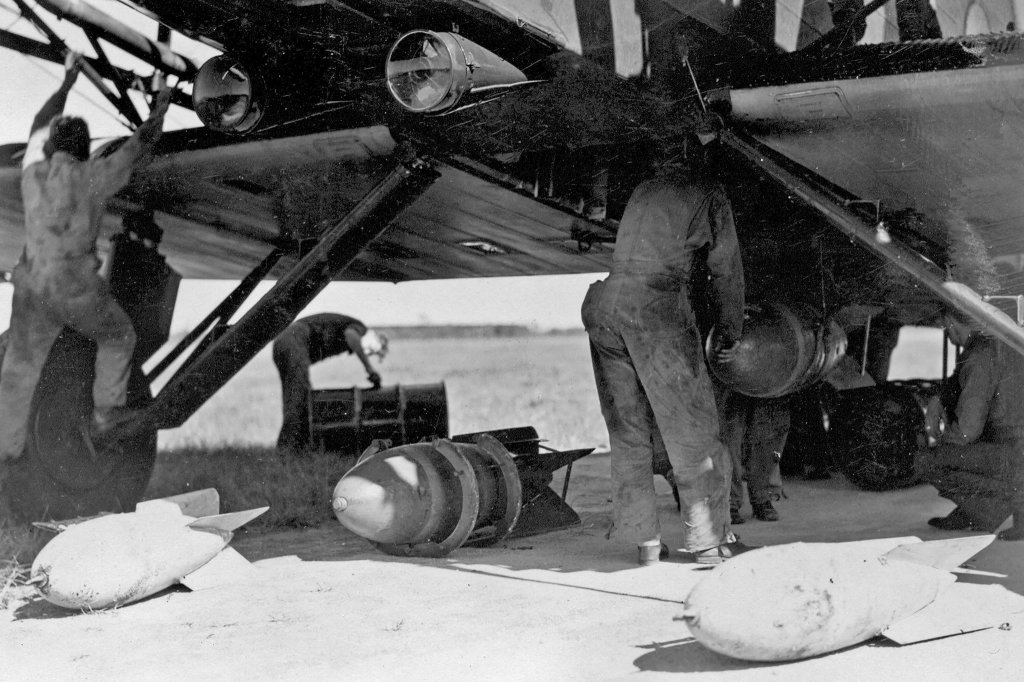
The mission was considered a success at the time, since the lava flow stopped six days later, with the Director Jagger saying “The Army in one day’s work has stopped a lava flow, which might have continued indefinitely, and have caused incalculable damage to forest, water resources, and city.” A survey of the lava field four years later reinforced this idea and so when there was another eruption on Hawai’i in 1942, bombers were used to attack the lava flow with similar results, the flow ended a few days after the bombing.
Research done in the 1970s by the USAF bombing volcanic tunnels with a variety of bombs from fighter-bombers (having to get rid of the Vietnam War stockpile somehow), showed that delayed fuze bombs might be able to collapse lava tunnels, but the effectiveness against active lava flows is questionable according to engineers and geologists.
Want to see more stories like this: Follow my vapour trail on Twitter: @Hush_kit

Preorder your copy today here.
From the cocaine, blood and flying scarves of World War One dogfighting to the dark arts of modern air combat, here is an enthralling ode to these brutally exciting killing machines.
The Hush-Kit Book of Warplanes is a beautifully designed, highly visual, collection of the best articles from the fascinating world of military aviation –hand-picked from the highly acclaimed Hush-kit online magazine (and mixed with a heavy punch of new exclusive material).
“the thinking-man’s Top Gear… but for planes”.
The solid well-researched information about aeroplanes is brilliantly combined with an irreverent attitude and real insight into the dangerous romantic world of combat aircraft.


Sadly, this site will pause operations if it does not hit its funding targets. If you’ve enjoyed an article you can donate here and keep this aviation site going. Many thanks
This great mission showing the power of man over nature has been memorialised in the unit insignia for the 23rd Bomb Squadron, now a B-52H squadron in chilly Minot North Dakota. And the bombings aren’t forgotten in Hawai’i as the empty casings from the smoke bombs are still being found, most recently in late February 2020. And the commander who decided that bombing a volcano was a good idea in 1935? Lt Colonel George S. Patton.
––– Mark Brueschke is an Aviation fan and geology hobbyist who grew up watching B-52s and B-1s constantly flying over while living by Minuteman silos

10 Obscure Air Attacks

A lot of explosive and incendiary devices have been dropped on a lot people’s heads. We climb through the limb-littered wreckage to bring you 10 bombing raids & mishaps you probably haven’t heard of.
Venice 1849

Austrian forces besieged the wettest city in the world in 1849 and tried to burn it down. They launched over 200 paper hot air balloons, each carrying a 26-pound bomb with a time-fuse. Most were launched from land, but some from the steamer ship SMS Volcano.. named for Vulcan, the Roman god of fire. In the first historical example of a Vulcan raid only hitting the target once, only one bomb got through. The rest turned back when the wind changed and some even landed back on the Volcano causing some fire damage.
Italy hits Britain

Ask a typical British person about the aerial bombing of Britain in the early 1940s and they’ll tell it was carried out by the German air force. What they are unlikely to know is that the Italian air force also had a go. The Corpo Aereo Italiano (Italian Air Corps), or CAI, was an expeditionary force from the Italian Regia Aeronautica (Italian Royal Air Force). Equipped with inferior aircraft to the RAF and Luftwaffe, it took part in the Battle of Britain and the Blitz during the final months of 1940.
On the last day of the Battle of Britain, 29 October 1940, fifteen BR.20s were sent to bomb England as revenge for British attacks on Northern Italy. The aircraft, painted in an inappropriately bright camouflage scheme for the South of England approached at low level in a very tight formation, escorted by CR.42s. The CR.42 Falco biplane fighter faced far faster and better-armed Hurricanes and Spitfires. On paper it looked totally outclassed but had two aces up its sleeve: the ability to soak up British .303 rounds and fly on, and arguably the smallest turning circle of any fighter of World War II. But generally it was hopeless against the more modern British machines, in fact so much so, that at least one pilot ‘mistakenly’ landed his FIAT in Suffolk rather than trust his life in the chubby machine against Fighter Command (and no one could truly blame him). In the October 29 raid five aircraft were damaged by British anti-aircraft guns. A Royal Marines depot in Deal, Kent, was hit with high explosive bombs six. The CAI was moderately successful but it was ultimately just a symbolic contribution to a failed campaign.
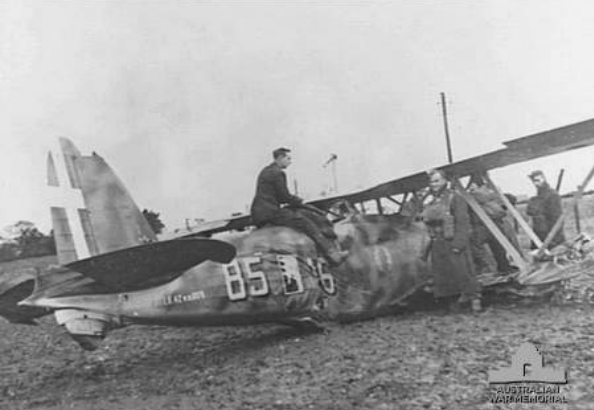
Torrey Canyon
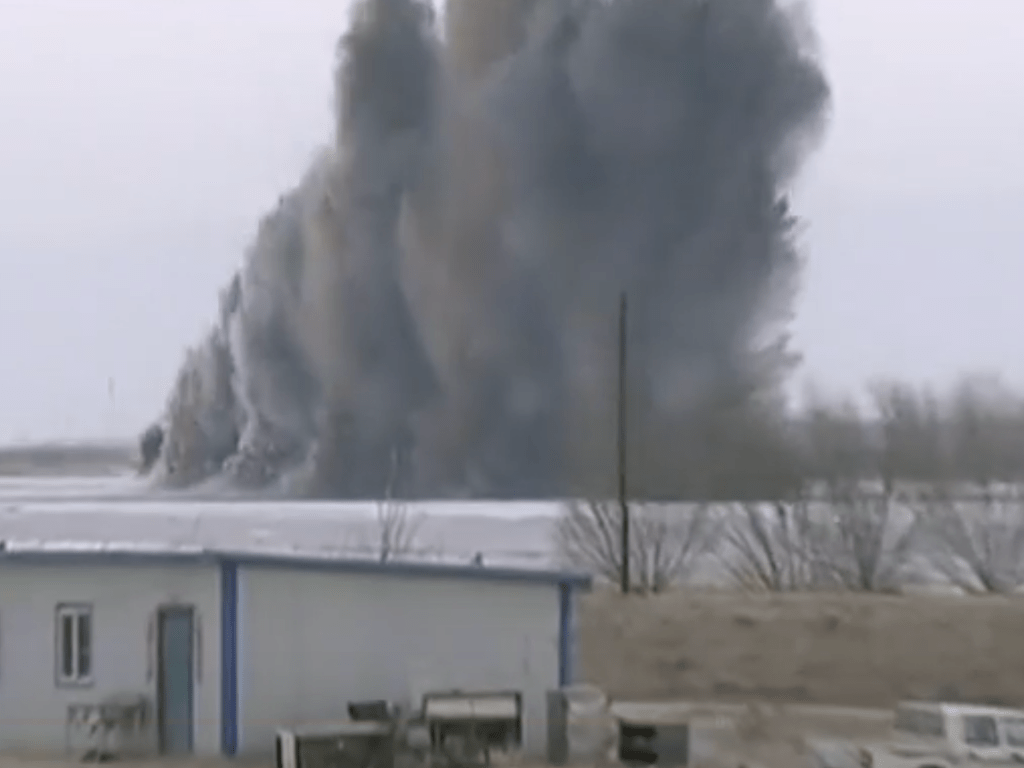
The greatest achievement of Britains’s Royal Air Force and Fleet Air Arm in the 1960s was failing to adequately dispose of a leaking oil tanker and the subsequent oil slick. The supertanker, Torrey Canyon, had run into trouble and was vomiting 30 million gallons of oil off the south west coast of England. Something needed to be done to stop the oil killing vast swathes of ocean life and poisoning the sea. The obvious solution was to ignite and burn the oil, and sink the ship. So, on 28 March 1967, the Britain’s Fleet Air Arm sent Buccaneer strike-bombers from RNAS Lossiemouth to drop forty-two 1,000-lb bombs in an attempt to destroy the ship. At least 25% of the bombs missed. Then, the Royal Air Force sent Hawker Hunter jets from RAF Chivenor to drop cans of aviation fuel to set the oil ablaze. However, exceptionally high tides put the fires out. Further attacks were required. Sea Vixens were dispatched from RNAS Yeovilton, along with Buccaneers from the Royal Navy Air Station Brawdy, and yet more RAF Hunters, this time armed with napalm* to ignite the oil. Bombing continued into the next day before Torrey Canyon finally sank. The result was an environmental catastrophe. Still, at least it made David Bellamy famous.
*As an aside, pilots Hush-Kit have spoken to say that napalm remained in the RAF inventory far longer than is publicly acknowledged.
Chinese frozen river bombing


In 2014 the Yellow River froze in Inner Mongolia. The ice was blocking the flow of water and causing freakishly high water levels risking mass floods. Though bombing a river may sound like metaphor for a futile act, in this case it was an actual, and successful, solution. At least three Xian H-6 (a Chinese-built Tu-16) strategic bombers took part dropping 24 unguided bombs. They all hit the target and broke the ice.
(Speaking of rivers and bombing, in World War II Britain did all it could to deprive Luftwaffe intruders of navigational references. In an experimental effort some rivers were covered in coal dust to minimise how much moonlight they reflected.)
Want to see more stories like this: Follow my vapour trail on Twitter: @Hush_kit

Preorder your copy today here.
From the cocaine, blood and flying scarves of World War One dogfighting to the dark arts of modern air combat, here is an enthralling ode to these brutally exciting killing machines.
The Hush-Kit Book of Warplanes is a beautifully designed, highly visual, collection of the best articles from the fascinating world of military aviation –hand-picked from the highly acclaimed Hush-kit online magazine (and mixed with a heavy punch of new exclusive material).

“the thinking-man’s Top Gear… but for planes”.
The solid well-researched information about aeroplanes is brilliantly combined with an irreverent attitude and real insight into the dangerous romantic world of combat aircraft.


Sadly, this site will pause operations if it does not hit its funding targets. If you’ve enjoyed an article you can donate here and keep this aviation site going. Many thanks
French bomb Berlin
The first Allied bombing of Berlin was utterly audacious. It involved a single airliner converted into a makeshift bomber manned by a former airline crew. The solitary French navy NC 223.4 (named ‘Jules Verne’) painted matt black and with only a light machine-gun for self defence took off in the afternoon of the 7 June 1940. Its perilous route took it across the North Sea, Denmark, the Baltic sea, and changed course at Stettin in Poland (note the similarities to the Soviet raid described below). It reached Berlin in the dark of night. In an attempt to disguise itself as a friendly aircraft it faked an approach path to Tempelhof airfield. It then launched its attack on its target: the Siemens factory in Berlin’s suburbs (a company with a distinctly shady wartime history). Approaching at rooftop level the sole intruder rained down high explosive and incendiary devices. It is said that when they ran out of bombs, the bombardier threw down his shoe. Dodging anti-aircraft fire, the Jules Verne fled the scene. It safely landed at Orly airfield, near Paris, on the morning of the 8 June morning, after a gruelling eleven hour and forty minutes of flight.
Soviets bomb Berlin
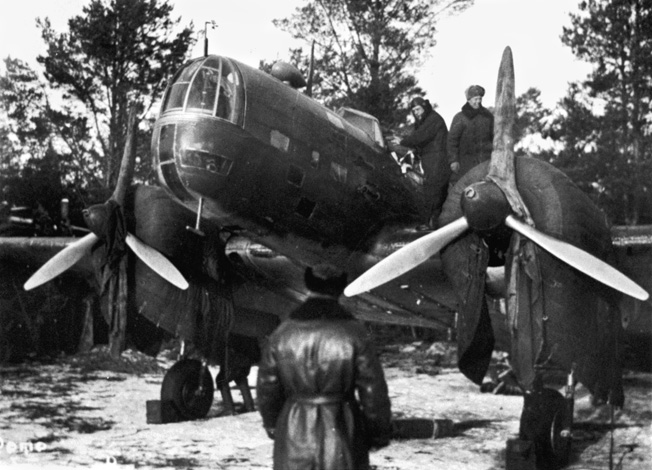
In July 1941 the Soviet Union was on its knees. The German bombing of Moscow was a painful humiliation to this already battered nation. They could not be shown to be impotent in the face of an assault on their own capital – the attack needed to be avenged. This was easier said than done. The air force had taken a pummelling during the German assault and was severely mauled. That month, German Luftwaffe commander Hermann Göring told Hitler with some pride that the Soviet air force was no more. The situation was dreadful: the Wehrmacht dominated the Baltic region, half of Ukraine, the Byelorussian Soviet Socialist Republic and was now approaching Moscow itself. A revenge attack would show the world the USSR could still bite back. It would be a much-needed shot in the arm for the beleaguered Soviet people. And they would need all the morale boosts they could in the face of history’s most formidable invaders. But there were no bomber air bases still in Soviet hands that were in range of Berlin.

A plan was hatched of incredible audacity. They would use rough and ready airstrips on the Moonsund archipelago, which was located in the eastern part of the Baltic Sea. This was a bold move – German troops were very close to the main Baltic Sea base of Tallinn, and were approaching the Gulf of Finland. The area was also patrolled by Finnish fighter aircraft. The airfield had none of the infrastructure to support a bomber force, no arsenal of bombs or mass supply of aviation fuel. Even if, against all odds, the raids were mounted – it was still a 900-km round against an extremely heavily defended city.
First must come the base preparation, a daring feat in itself. Admiral Nikolay Gerasimovich Kuznetsov noted in his book “Under heavy protection, small barges loaded with gasoline and ammunition traversed the mined waters of the Gulf of Finland to Tallinn, and then on to the island of Osel. Danger lay in wait for them at every turn. It should be noted that Tallinn was already being besieged by the enemy.” If the Luftwaffe spotted the activity the plan would be over. The aircraft, Ilyushin DB-3s, arrived and were quickly dispersed around the island next to homes and gardens – and hidden under artful camouflage netting.

On August 6, five DB-3s aircraft took off to reconnoitre Berlin. They succeeded and returned to the island unharmed. A larger raid would be more conspicuous and more vulnerable. Whereas the state-of-the-art British Lancaster bomber weighed over 30 tons fully loaded, had four engines and eight or ten defensive machine-guns, the DB-3, a long-range bomber from 1935 weighed a mere ten tons fully loaded, had two engines and only three or four defensive guns. Even the incredibly tough Lancasters would suffer over Berlin – the Soviet bombers were far more fragile and the crews less experienced. Also, if the German defenders had observed the recce mission – which came from the North – they would prepare for other raids from this unlikely direction.
Two days later, 15 fully loaded DB-3 bombers departed in the middle of the night. They traversed the Baltic Sea before turning towards Berlin from Stettin over occupied Poland. The Berlin defenders were initially baffled by the unfamiliar two-engined aircraft approaching from the north. Thinking they must be friendly aircraft the German defences even radioed the Soviet raiders inviting them to land! Against all odds, the raid was a complete success for the Soviets. Berlin paid with the blood of civilians. A further nine raids were mounted. By the end of 1941, the Soviet air force and navy had dropped 36,000 kilograms of bombs on Berlin. They lost 17 aircraft and 70 crewmen were killed.
Ireland (1940-41)
Ireland was neutral in World War II, so it is surprising to learn that it was attacked eight times in 1940-41 by the German Luftwaffe. On the 26 August 1940 five bombs were dropped next to a creamery in County Wexford. Five bombs were dropped and three women were killed. According to an eye witness quoted in the Irish Times, “When we had the fire under control we called the roll, and found that everybody had been accounted for except three girls…One of these we found slumped over a table, with her head blown off, and another had apparently tried to get down some stairs. We were only able to identify them by their clothing.” The one bomb that failed to detonate had Luftwaffe markings.
The worst attack came on 31 May 1941 when four German bombs fell on North Dublin in the North Strand area, killing at least 28 (some reports say 34) people.
But why? Opinions are divided. Some of the bombers may have had their navigation aids misguided by British countermeasures, some may just been lost but it is likely that at least some of the raids were intentional. It may have been that the Germany leadership was angry at the Republic for providing emergency support to civilians injured in North Irish locations close to the border. Reparations were paid to Ireland.
America nukes itself
Nothing makes more sense than nuclear weapons. Simply have some machines that can instantly kill cities, incinerate millions, irradiate the planet and cause problems that will last for hundreds of years – and nobody wants to fight you. Thanks to these miraculous devices there have been no wars since 1945. Obviously these doomsday bombs are treated with great reverence and no mistakes can happen. This is why the United States has never accidentally sent an atomic bombs crashing around in the wrong place..except they have, and not just once, but at least 32 times.
One of the worst was the 1961 Goldsboro B-52 crash, that occurred near Goldsboro, North Carolina on 23 January 1961. A Boeing B-52 Stratofortress disintegrated in mid-air, dropping its two 3–4-megaton Mark 39 nuclear bombs in the process. Five crewmen successfully escaped from the aircraft and landed safely. One ejected, but did not survive the landing. Two were killed in the crash. Information only declassified in 2013 showed that one of the bombs came very close to detonating.
Fortunately this kind of thing took place in some far off idiotic ‘Mad Men’ time and wouldn’t happen in our world, except it does: On 29 August 2007, six AGM-129 cruise missiles with W80-1 variable yield nuclear warheads, were mistakenly loaded onto a B-52H at Minot Air Force Base in North Dakota and flown to Barksdale Air Force Base in Louisiana. The nuclear warheads should have been removed from the missiles before they were taken from their storage bunker. The nuclear warheads were not reported missing, and remained AWOL for 36 hours. During this period, which could have gone very wrong indeed, the warheads were not protected by the security precautions necessary for nuclear weapons. It was also a reassuring lesson to ambitious terrorist that such weapons could go missing for almost two days without anyone noticing.
On December 5, 1965, an A-4E Skyhawk attack aircraft carrying a 1-megaton bomb rolled off the deck of its aircraft carrier 80 miles from Japan’s Ryuku island chain. The bomb, which was illegally in Japanese territory, has yet to be found.
The Nuclear Weapon Ban Treaty, is the first legally binding international agreement to comprehensively prohibit nuclear weapons with the ultimate goal being their total elimination. It will enter into force on 22 January 2021. As of 25 October 2020, 84 states had signed the Treaty.
Switzerland
Switzerland was a neutral country during World War II, but it was in an Axis neighbourhood. Considered the vagaries of wartime navigation and the huge scale of the Allied bombing campaign it is perhaps unsurprising that the odd accidental bombing would happen. It is the scale of these tragic mistakes that might surprise: Switzerland was bombed over seventy times – and 84 people were killed.
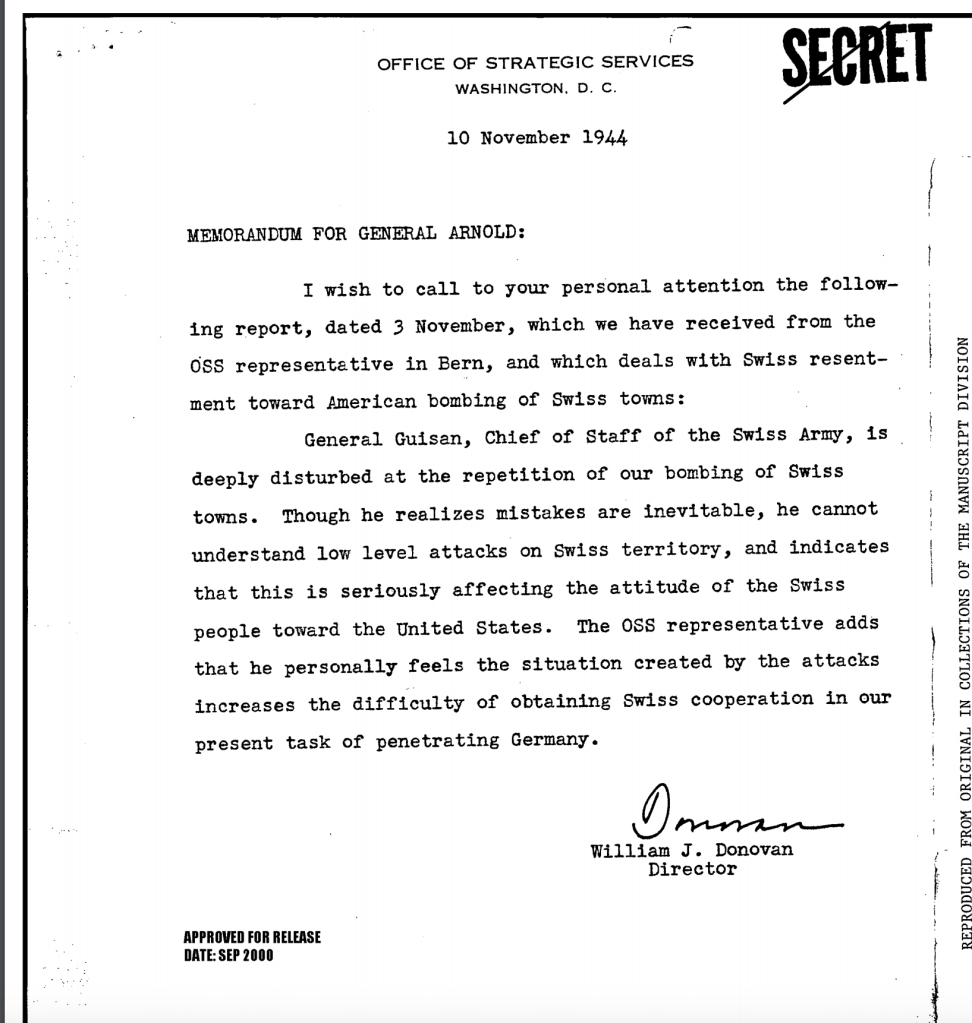
The Formiga Raid On April 2, 1987, the Mayor of Formiga, Brazil, was contacted by telephone to receive the alarming message, “‘Hey, mayor. Run over to the park, the Government is attacking us with a plane.”. There had been public demonstrations against the high interest rates imposed by the President – was this a message from the Government? Two bombs were dropped on a residential area causing seven metre deep holes. The impact had been heard across the city. After dropping the bombs the aircraft turned back and circled the area they had struck. The residents of Formiga were terrified and look skyward expecting further attacks, panic spread. What had happened? Earlier, two Brazilian air force F-5s took off from the Santa Cruz Air Base, in Rio de Janeiro, for a routine training mission. The aircraft were supposed to fly to Formiga and make a simulated attack on a bridge. The aircraft carried inert concrete-filled 230-kg training bombs. The bombs were not to leave the aircraft, they were just there to give the pilots a realistic experience of flying a laden bomber. They were dropped by accident and the pilots had flown back to assess the situation. According to defence journalist Roberto Caiafa, quoted in Globo.com, “the pilot of the plane that lost the bombs received an alert on the control panel…He and the pilot of the other fighter went crazy. They went back and started flying over the city centre at low altitude, looking for the crash site.” A furious response from the traumatised people resulted in a government pay-out. This was used to create a pretty new park area in the shape of a target with one of the bombs mounted as a statue. Hopefully the target-shaped development will not attract further aerial attacks.
(Thanks to @Cardoso for flagging up the Formiga story)
The aeroplane types a drowning sailor most wants to see

Stephen Caulfield (with support from Jane Morton, Paul E Eden, Sean Kelly and Joe Coles) goes in search of the 15 most noteworthy aeroplanes of oceanic mercy.
15. Curtiss Model F
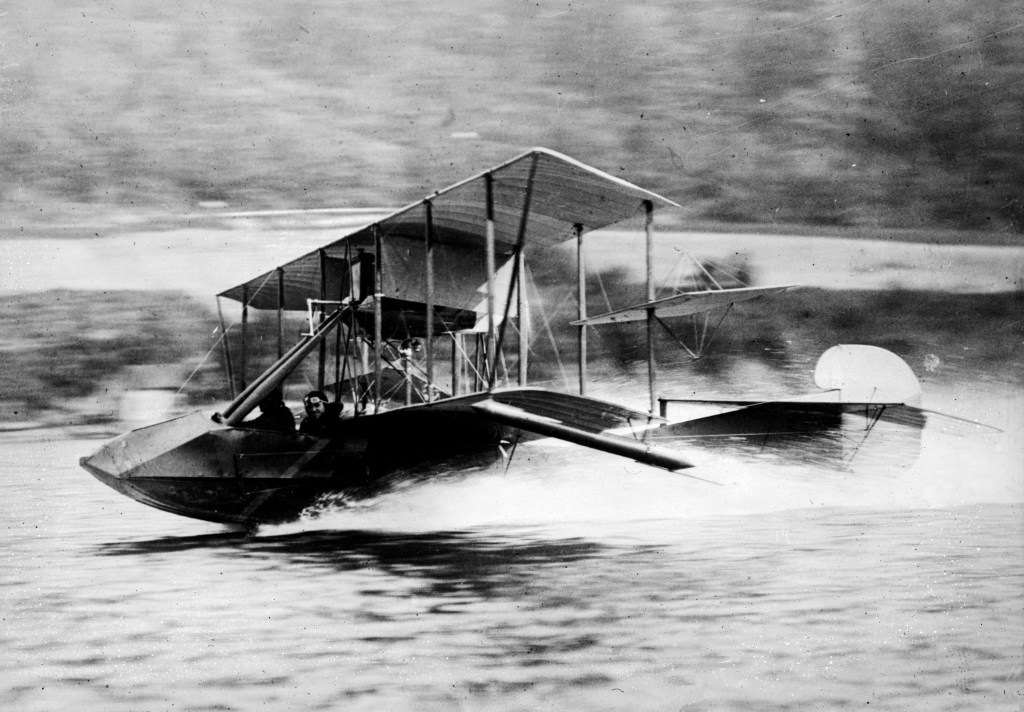
Lake Michigan is a cold mass of fresh water in the United States. At around two-thirds the size of Scotland it will conjure up dramatic weather at very short notice. It seems fitting that history (sketchily) records the first known air-sea rescue as having taken place there in 1910.
Two Curtiss F-series seaplanes were involved. One of their pilots was compelled to make an emergency landing. The other, knowing imminent harm when he saw it, splashed down and recovered his colleague.

Haphazard rescues of opportunity like this would typify air-sea rescue for most of the next three decades, including the four years of the Great War. This lack of a truly organised search and rescue force was in spite of how dangerous the world was in this tumultuous period. Seaplanes were the obvious choice for saving those in peril on the waves but the land-planes would be there, too.
In an emergency could be mistaken for: Blanchard Brd.1

14. Republic P-47D Thunderbolt

Just when you thought the mighty ‘Jug’ couldn’t be any more amazing, you discover the eight-gun bruiser had a side-gig saving lives. A roaring surplus of horsepower got them to the scene pretty damn quick too, which was of vital importance for those requiring its services. Thrown around by a gloomy North Sea, most likely with hypothermia and injuries, bomber crews wouldn’t last long. Lacking the well organised British rescue system, the USAAF set up their own – allotting older, war-weary ‘razorback’s (earlier variants that lacked the bubble canopy) to an improvised unit called the 5th Emergency Rescue Squadron based at Boxted Airfield near Colchester. Whenever a bomber mission was launched, two P-47 Thunderbolts of the Air Sea Rescue.

Their war weary mounts had the usual pylon loads replaced with smoke floats and flares, but kept their .50 calibre heavy machine-guns just in case they were needed. A canister with an air-drop capable raft was attached to the centreline rack. Some rescue Thunderbolts are recognisable thanks to a rare sliding ‘bubble’ canopy with reduced framing to improve the pilot’s view. The unit saved 938 lives. Somebody buy this fighter a beer. Right now.
In an emergency could be mistaken for: the Mitsubishi A7M Reppu.
13. Dornier Do 24

Look at the long graceful lines on the Do 24’s fuselage. It’s the prettiest plane here. Of course, all rescue planes probably look extremely beautiful to a man who has spent a week in a leaky rubber dinghy with no water, food, sunblock, or much company beyond the circling hammerheads. But the tri-motor Dornier is eye-pleasing to even the less desperate observer, and carried out an enormous number of maritime rescues; around 12,000 souls were saved.

Fascist Spain was supplied with Do 24s in order to boost recovery of Axis personnel from the Mediterranean and kept them for a long time. Air Enthusiast’s January 1972 issue features photos of such a Do 24 landing on Lake Constance at Freidrichshafen the previous August. Still in Spanish SAR markings it had only just been retired, and was returning to the Dornier plant for restoration and museum display.

In an emergency could be mistaken for a Blackburn R.B.2 Sydney.
12. Boeing SB-29

The B-29 has a ghoulish legacy for mass destruction, but it had its more caring moments, too. This SAR adaptation of the Superfortress carried a new type of lifeboat. The EDO Corporation and naval architect Henry Higgins felt that the previous Mark I and II Airborne Lifeboats were good, but could be improved upon. They feared the much greater distances involved with campaigns in Asia would overcome the capacity of the then current British design (created by English boat designer and sailing enthusiast Uffa Fox). The Americans had self-righting vessels and favoured metal over wooden hulls. The resultant machines were the A-1 and A-3, deployed on modified B-17s and B-29s respectively. As the bomber war ramped up in the Pacific, so too did the quality of the equipment and the size of the infrastructure, to save servicemen downed at sea. With an emphasis on organised teamwork, air-sea rescue came of age in World War II. Over-water routes to Japan necessitated a serious array of assets for aircrew recovery. Thousands of personnel at a time might be involved in a post-raid SAR operation. They could be found at the hard-won island bases, in surface ships, submarines, seaplanes, and crewing the SB-29s. Radio communication, radar and electronic navigation guides formed the vital brain of this vast, dangerous operation.

In an emergency could be mistaken for the Bell X-1’s mother ship or a B-50.
- Vickers Warwick ASR
Tool of choice for the Warwick was the Airborne Lifeboat Mks I and II. Designed by the champion yachtsman Uffa Fox, the lifeboats were packed full of useful goodies to aid survival at sea: a Webley & Scott flare signal pistol with lots of rounds and a flashlight with spare filaments for starters; storm suits for seven men, later ten; rations, rope, cigarettes, signal rockets, 28 tins of sugared condensed milk… and a pint of massage oil (presumably for conjugal distractions).
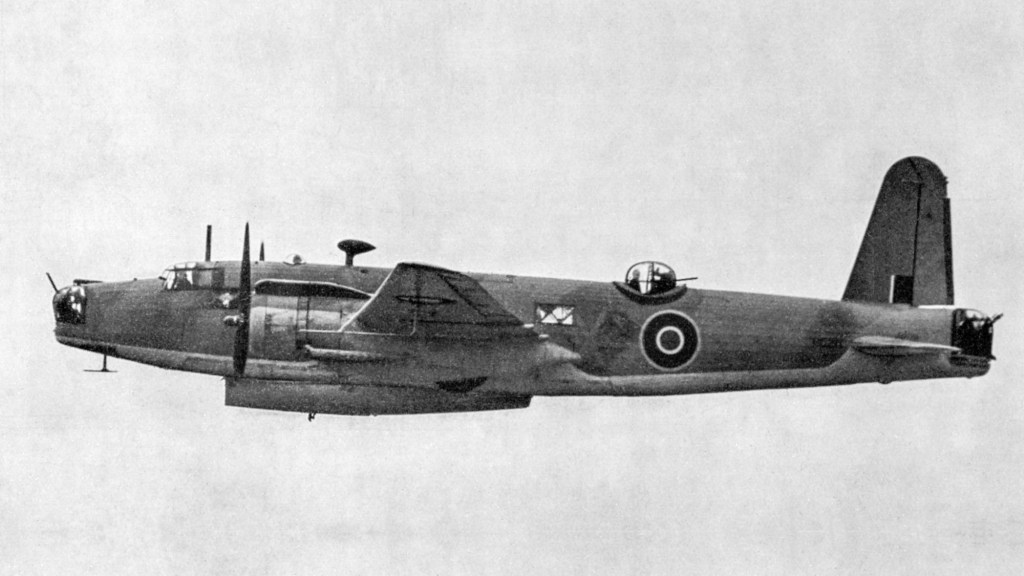
Buoyancy chambers, sails, paddles and a pair of two-stroke inboard engines made the Mk I a substantial craft. A Vincent motorcycle engine powered the slightly larger Mk II. Though one wonders how much small-boat handling skill the average flyer had at the time, thousands of lives were saved by these boats. Lockheed Hudsons were first with the Mk I, but the Warwick replaced them as the primary RAF lifeboat bomber of the war. The Warwick was a larger cousin to the Vickers Wellington. Not quite big enough to go bombing with the four-engine heavies, it was not really needed in roles given to the more numerous Wellington either – it was assigned transport, weather-reconnaissance and SAR work instead.
10. Boeing PB-1G/SB-17

Once in the vicinity of a crash, the crew of a lifeboat bomber like the SB-17 (a converted B-17) had a challenging mission. First they would scan the water for flotsam, smoke, flares, marker dyes or lights. Often the conspicuous glimpse of a yellow dinghy on blue water revealed the presence of survivors.
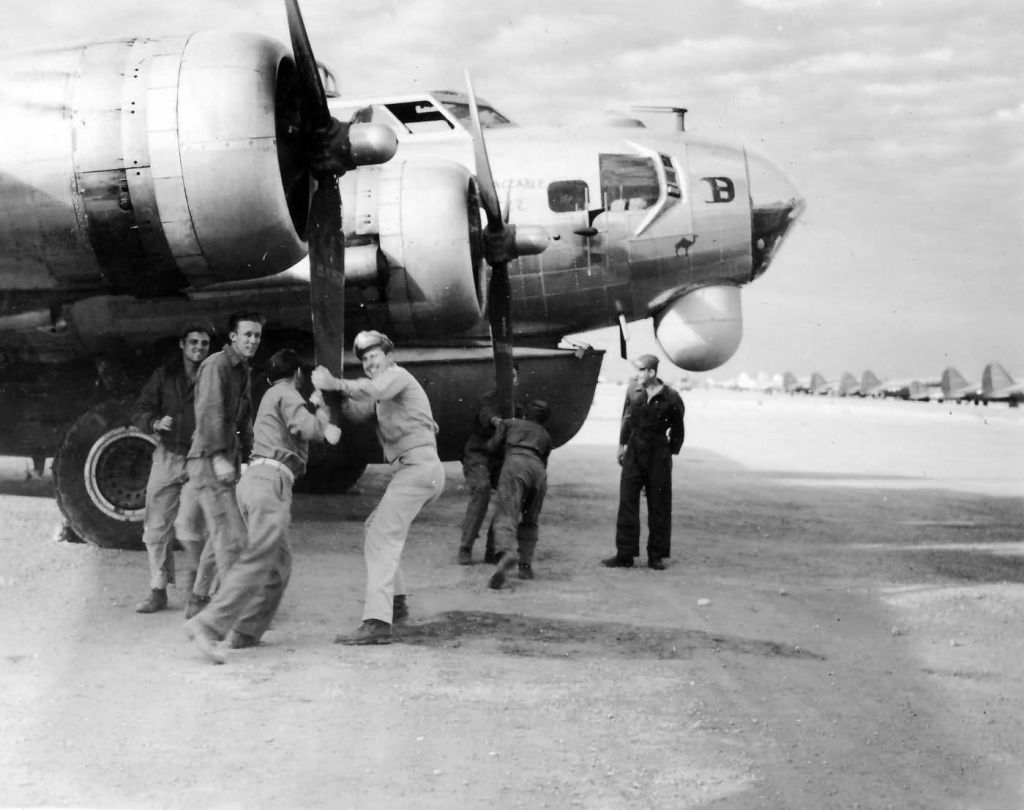
The rescue aircraft then roared by (on an upwind course) to one side of the ‘target’. It would then use its standard issue bombsight to aim the air-launched lifeboat.
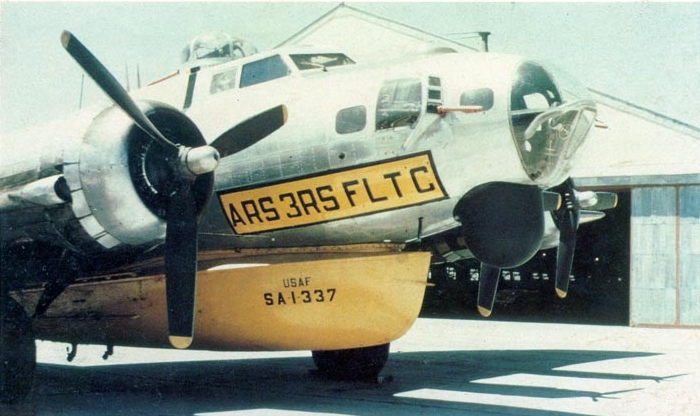
After release, big parachutes slowed the lifeboat’s descent enough to minimise the possibility of damage when it hit the sea. On impact, CO2 cylinders would automatically inflate buoyancy tubes, which also triggered half a dozen rockets. The rockets would trail ropes with floats in multiple directions around the lifeboat to help the downed airmen secure it.
If you don’t find any of this massively exciting, you are dead inside.
.

In an emergency could be mistaken for a Piaggio P.108.
9. Avro Lancaster
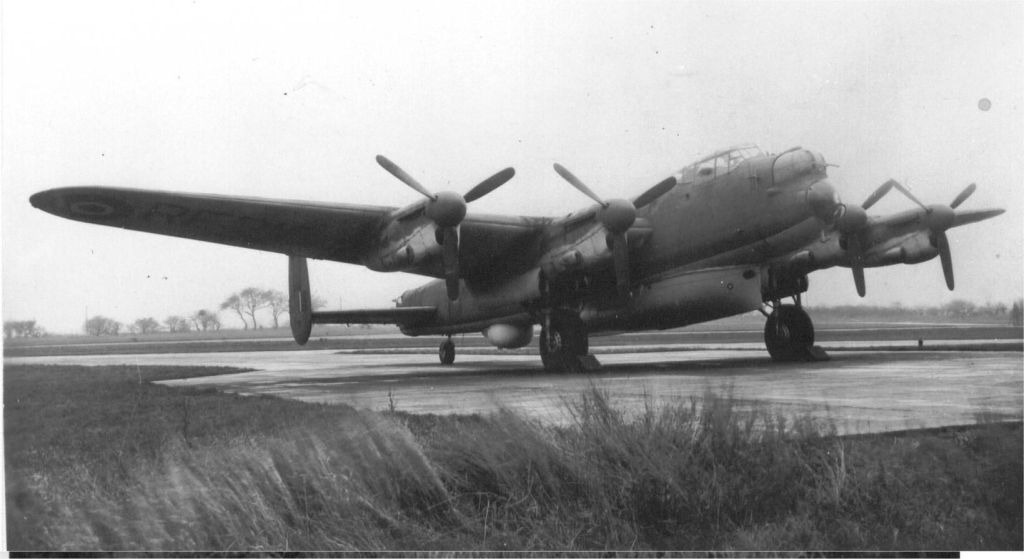
The UK’s formal air sea rescue (ASR) capability was just five years old when the Lancaster became its primary airborne asset. Established in February 1941, the Directorate of Air Sea Rescue Services morphed into the Royal Air Force Air Sea Rescue Service by year-end.
While the Supermarine Walrus is forever associated with RAF ASR, the need to reach beyond the seaplane’s limited capabilities saw landplanes locating stricken crew and dropping essential supplies. Fortunate crews thus had a reasonable chance of surviving until a boat or Walrus arrived; sometimes a Catalina of Sunderland flying-boat was available, but these were needed urgently on the front line and could not be relied upon to provide succour.
In May 1943, a Lockheed Hudson deployed an airborne lifeboat operationally for the first time. Now, long-range landplanes could deliver the means to survive until rescue came, and the means to sail towards it. The recalcitrant Vickers Warwick had been intended as the lifeboat carrier and finally came on strength in October 1943, but was never particularly serviceable.
An obviously more suitable aircraft for ASR conversion had entered combat in March 1942. Thereafter, the Avro Lancaster’s brilliance at bomb dropping meant none could be spared for lifeboat dropping. Nonetheless, the type’s capacious bomb bay, range and reliability lent it to ASR, and conversion work began almost as soon as the war in Europe ended.
In February 1946, the RAF’s grateful ASR units began receiving the Lancaster ASR Mk III and discarding their Warwicks. The mid-upper gun turret of the modified ‘Lancs’ was removed, plus they had provision for a lifeboat, and observation windows installed in the rear fuselage.
With a change in military aircraft designations, the ASR Mk III became the ASR Mk 3. Under this title, the Lancaster accomplished its first successful lifeboat drop, in May 1947. The aircraft involved belonged to 120 Sqn, today the RAF’s premier Poseidon operator.
Yet the operational landscape was changing. Search and rescue trials with the Sikorsky Hoverfly helicopter had begun in 1946. Meanwhile, the Catalinas and Liberators delivered under wartime Lend Lease were returned to the US, leaving the UK short in maritime patrol provision.
The Lancaster ASR Mk 3 was ideally positioned as a stop gap – a change in designation to MR Mk 3 (MR for maritime reconnaissance) signalling that, from 1950, MR rather than ASR was the type’s primary mission. Later, this broadened to GR (general reconnaissance) before the Lancaster naturally gave way to the Shackleton.
The Lancaster served as a dedicated ASR platform for only four years, but bridged a decisive period in which ASR became SAR. Through the Lancaster, the skills learned in wartime were passed on to a new generation of personnel flying modern maritime aeroplanes, which evolved to support the helicopter as the primary means of rescue.
In an emergency could be mistaken for a Handley-Page Halifax.
Paul E Eden is the author of The Official History of RAF Search & Rescue
8. Beriev Be-12PS ‘Chaika’

Designed just as seaplane development was cresting, the gull-winged Chaika (‘seagull’) amphibian is a remarkable machine that only entered service in the early 1960s. With typically tough Soviet engineering, this powerful turboprop was created for the serious business of maritime patrol and anti-submarine warfare. But it was in the role of search-and-rescue that the Be-12 lasted well into the post-Soviet era, saving the unfortunate from death in the world’s coldest bodies of water. Chaikas also grabbed 42 in-class world records in their spare time – several for climb and speed still stand, and may well stand forever. The two Ivchenko Progress engines generate a total of 10,632 horsepower, equivalent to six of the ultimate Rolls-Royce Merlins. Still in service with the Black Sea Fleet sixty years later, the Be-12 is assured a place in a notional Commie Warplane Hall of Fame for Longevity. Whatever else you care to say about the USSR, some of its military-industrial artefacts are simply excellent… generally ugly, but excellent. Beriev is still in the emergency flying-boat business in 2020 with the uniquely jet-powered Beriev Be-200 Altair.
7. Grumman HU-16 Albatross
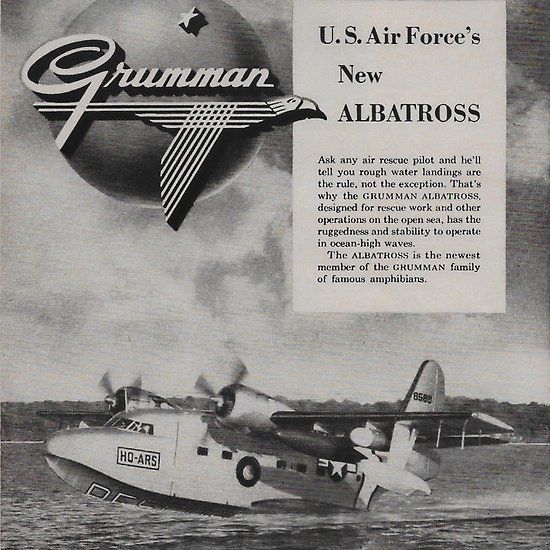
The design of the Albatross benefitted from the wealth of experience of seaplane operations during the wartime years. Grumman’s expertise in creating extremely robust aircraft that could withstand operations near or in water resulted in a superlative aeroplane, which took its first flight ten days after Yeager went supersonic on 24 October 1947. The doughty Albatross proved extremely survivable, and could safely manage ten-foot waves. It was sent to places that no other aircraft could reach, and in the Vietnam War proved carried out some utterly hair-raising missions American military HU-16s often resorted to RATO bottles in order to return to the air from a churning sea with the extra weight of survivors aboard.
6. ShinMaywa US-2
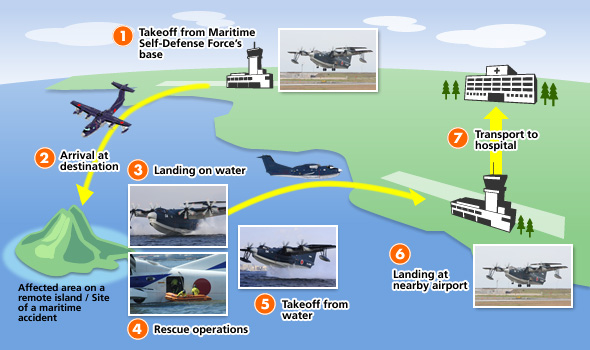
After Japan’s defeat, the Kawanishi Aircraft Company which had been responsible for Imperial Japan’s finest flying-boats and floatplanes, stopped work on manned suicide missiles and was reborn as Shin Meiwa Industries (later ShinMaywa). They built upon their legacy of superb wartime aircraft with results culminating in one of the most impressive aircraft in the world today. There is nothing like the US-2, it is the best prop-driven flying boat design ever made. This amphibian is a radical update of the 1960s US-1 introducing the best of early 21st century technology. The secret of its remarkable short take-off, which can be as small as 280 metres, is the ‘blown’ control surfaces; compressed air (from an engine developed for the Comanche stealth helicopter) blows down the control surfaces adding thrust – as well as steering the air flow from the main propellers. This dramatically reduces take-off distance and improves controllability. Controllability and flight efficiency is also enhanced by the presence of a modern fly-by-wire system. Seaworthiness needs to be impressive, and it is. Combined with features already mentioned, the well designed hull and spray suppressor (a gutter that re-routes spray) mean the aircraft is happy taking off in waters swelling with three metre waves.

The US-2 is in the same size category as the biggest flying boats of the Second World War, but they have far more power thanks to modern turboprop engines. With 18,000 shift horsepower it has four and half times more grunt than a Short Sunderland.
The unique qualities and general impressiveness of this aircraft aside, the US-2 project is a small programme – almost a boutique effort – capable of completing only two aircraft at a time. This means the cost per aircraft is likely around the £120 million mark. More export orders would help defray that issue but they don’t seem to be appearing in a hurry. Regardless, the sailors and airmen rescued at speed from the merciless Pacific never complain of the aircraft’s price tag.
- Heinkel He 59
Military aircraft developed in interwar Germany were dishonestly presented as civilian or mailplanes. The He 59 of 1930 was such a devious creation. Its true role (as a naval maritime patrol aircraft capable of torpedo bombing, minelaying and reconnaissance) was concealed. The type fought in the Spanish Civil War and at the beginning of World War II.
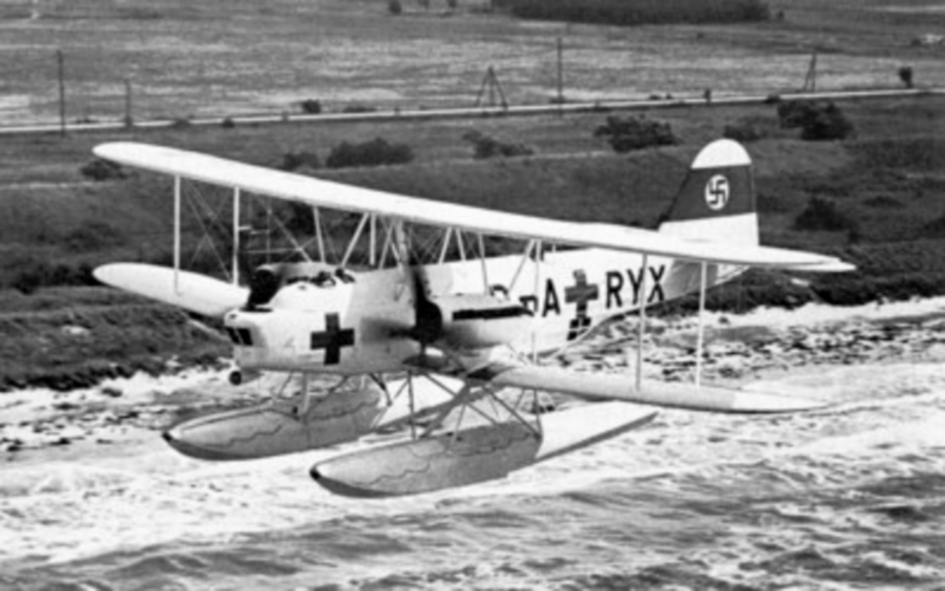
Painted white with red crosses like a flying hospital ship, this aircraft was deployed unarmed to French bases for the Battle of Britain. The idea was to work below the big summer dogfights, rescuing valuable airmen from the English Channel and North Sea. Shorter range designs hampered the Luftwaffe in the Battle of Britain. especially as its main fighter, the Messerschmitt Bf 109E, could barely manage a mission of 90 minutes. The Luftwaffe was the first combatant air force of the Second World War to create an air-sea rescue service, the seenotdienst. This formation was initially successful, but it wasn’t long until the Hurricanes and Spitfires came for them with gun buttons dialled to ‘FIRE’ rather than ‘SAFE’.

Controversy erupted in public on both sides over whether or not the Geneva Convention covered the civil-registered Heinkels. Rescue work has a moral as well as a utilitarian dimension, which can be subject to manipulation. The Third Reich’s propaganda machine turned its attention to this matter. Neither Churchill nor the RAF ended up wasting much sympathy on the German floatplanes, pointing out that the He 59s were fair game since they flew in clear and direct support of Luftwaffe aggression. In reality, it was a hard judgement call to make. One He 59 crew proved that even an underpowered biplane can get lucky once in a while by shooting down an attacking Hurricane.
In an emergency could be mistaken for the Gotha UWD.
4. Lockheed HC-130

Any description of an airframe as ‘the finest ever built’ is bound to be met with accusations of hyperbole, but the Lockheed C-130 Hercules has a very strong case for that title. Excelling in most noncombat roles, and even some combat ones, it was inevitable that the Herc would be adapted for search and rescue. Its combination of range—a USAF HC-130H set a turboprop distance record flying 8,372.09 miles (14,052.94 km) from Taiwan to Illinois in 1972—and robust build make it an ideal platform for numerous SAR duties, including C5ISR (command, control, communications, computers, cyber, intelligence, surveillance, and reconnaissance), refuelling of SAR helicopters, and air-dropping supplies to survivors.
The U.S. Coast Guard was the first to order the HC-130, doing so in 1958 as a replacement for the HU-16 Albatross and HC-123 Provider. Since then, the aircraft has proven its mettle repeatedly; a notable example took place in October 1980, when USAF and USCG HC-130s assisted in a joint US-Canadian operation to rescue the 519 passengers and crew of the cruise liner MS Prinsendam after the ship suffered a fire in the engine room off Alaska in the midst of a nearby Arctic typhoon. The Hercs, together with a Canadian Forces CP-107 Argus, coordinated the helicopter assets and acted as long-distance communications platforms. For years, USAF HC-130Ps were fitted with the Fulton surface-to-air recovery system; if you’ve seen Thunderball or The Dark Knight, you’ve got an idea of how this system, developed by the CIA, worked. In addition, HC-130s and their associate HH-60 helicopters from Patrick Air Force Base were on standby for every launch of the Space Shuttle.
And the HC-130 is only getting better. Both the USAF and USCG are acquiring SAR/CSAR variants of the C-130J Super Hercules, offering higher speeds and service ceilings as well as a 40% increase in range. The Air Force’s HC-130J Combat King II can provide aerial refueling for both rotary and tiltrotor aircraft, and can be refueled itself by any of the USAF’s turbofan tankers. The USCG’s Super Hercs feature the Minotaur integrated mission system architecture, offering superior information processing ability and significantly reduced upgrade and maintenance costs.
As a testament to the aircraft’s versatility and overall value, many of the USCG’s retired HC-130Hs, in the process of being replaced by a combination of the HC-130J and HC-27J Spartan, have been transferred to the U.S. Forest Service for use as aerial firefighters.

In an emergency could be mistaken for Shaanxi Y-9.
— Sean Kelly
3. Supermarine Walrus
The Walrus doesn’t look like air is its natural element. It’s an amphibian, but even the wheels look like an afterthought. No, it’s all about water; its star sign is Aquarius.
Is that surprising? It has a bilge pump; it carries an anchor. From its looks, you’d say Reginald Mitchell spent his holidays on the Norfolk Broads and was inspired to graft bi-plane wings and a pusher engine onto a cabin cruiser. It was intended for catapult launch from battleships, so he built it like one. You can loop a Walrus, but first check there’s no seawater in the bilges.
The small bomb load proved enough to sink a U-boat. But just as the Walrus was not quite an airplane, it was not quite a warrior. When the better, faster and meaner came along, it was given over to air-sea rescue. It found its true calling in saving, not killing.
For the half-drowned, who know hypothermia isn’t far off, a Shagbat was a blanket, a thermos of hot tea laced with rum, it was life. And when the weight of ten Americans from a ditched B-17 couldn’t be lifted, the pilot just pointed the bow towards England, and taxied home.
Jane Morton is a coder involved in an East-Anglian start-up technology company, and a sometime snowboard instructor. She likes flying boats and airships, especially British ones
Want to see more stories like this: Follow my vapour trail on Twitter: @Hush_kit

Preorder your copy today here.

From the cocaine, blood and flying scarves of World War One dogfighting to the dark arts of modern air combat, here is an enthralling ode to these brutally exciting killing machines.
The Hush-Kit Book of Warplanes is a beautifully designed, highly visual, collection of the best articles from the fascinating world of military aviation –hand-picked from the highly acclaimed Hush-kit online magazine (and mixed with a heavy punch of new exclusive material). It is packed with a feast of material, ranging from interviews with fighter pilots (including the English Electric Lightning, stealthy F-35B and Mach 3 MiG-25 ‘Foxbat’), to wicked satire, expert historical analysis, top 10s and all manner of things aeronautical, from the site described as:
“the thinking-man’s Top Gear… but for planes”.
The solid well-researched information about aeroplanes is brilliantly combined with an irreverent attitude and real insight into the dangerous romantic world of combat aircraft.
FEATURING
- Interviews with pilots of the F-14 Tomcat, Mirage, Typhoon, MiG-25, MiG-27, English Electric Lighting, Harrier, F-15, B-52 and many more.
- Engaging Top (and bottom) 10s including: Greatest fighter aircraft of World War II, Worst British aircraft, Worst Soviet aircraft and many more insanely specific ones.
- Expert analysis of weapons, tactics and technology.
- A look into art and culture’s love affair with the aeroplane.
- Bizarre moments in aviation history.
- Fascinating insights into exceptionally obscure warplanes.

The book will be a stunning object: an essential addition to the library of anyone with even a passing interest in the high-flying world of warplanes, and featuring first-rate photography and a wealth of new world-class illustrations.
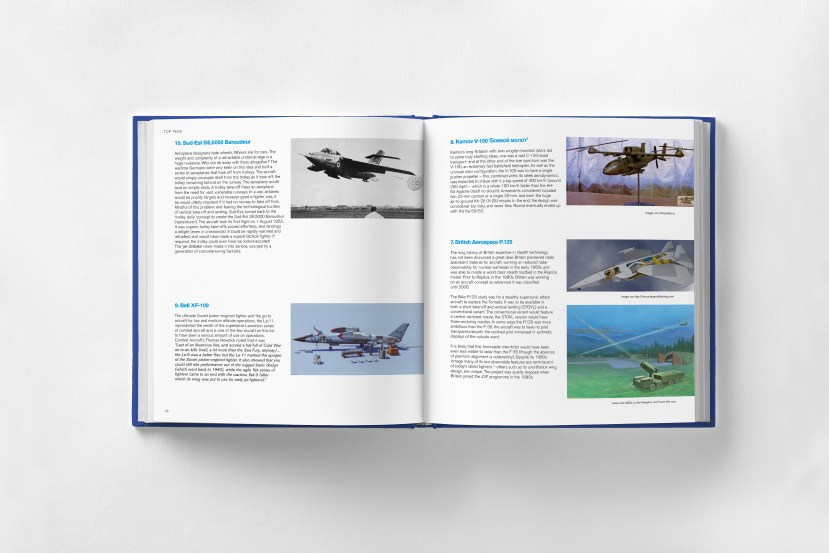


Sadly, this site will pause operations if it does not hit its funding targets. If you’ve enjoyed an article you can donate here and keep this aviation site going. Many thanks
2. Airbus CC-295 Kingfisher

The CC-295 embodies the diffusion into commonplace service of things that seemed cutting edge just a few years ago. Everything from advanced sensors, digital communications gear and glass cockpits to composite materials, winglets, and scimitar propellers have found their way onto this Spanish design assembled by Airbus in Seville. The Kingfisher is a recent SAR version for the Royal Canadian Air Force. Entering service this autumn, it replaces elderly examples of the C-130 Hercules and DHC-5 Buffalo. With a coastline five times longer than any other country, Canadians are well aware they need a capable search and rescue aircraft. Though late and expensive, the Kingfisher is just the plane they need.
In an emergency could be mistaken for either of the Alenia C-27 Spartan, EADS HC-144 Ocean Sentry or a Transall C-160.
1. Consolidated PBY Catalina/Canso/GST
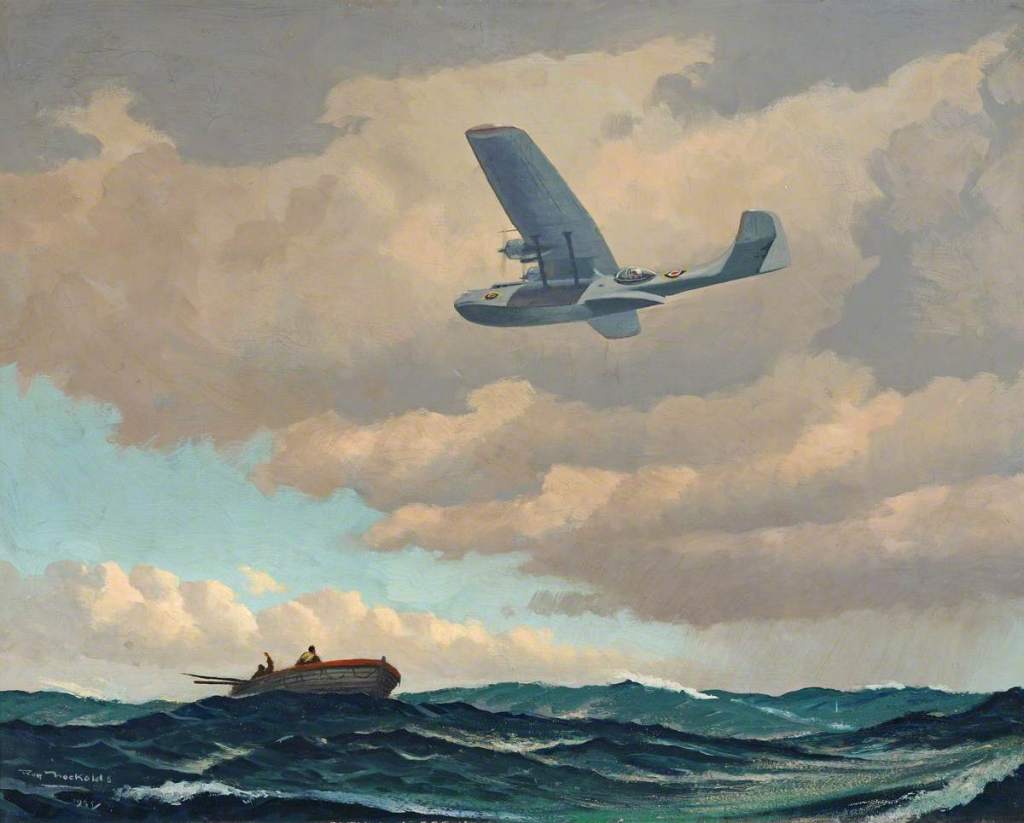
What a thing a PBY is. This aircraft is perfectly situated between the handsome and the pretty. It’s big, too: as long as two F-16s parked nose to tail, and with the same wingspan as a B-17G. That parasol wing was the first on a production aircraft to contain fuel. Small wonder the PBYs could do 10-, 20- and 30-hour flights across oceans and continents. No small feat in the 1930s and 1940s, but almost routine even for prototype PBYs. Size and range make all the difference in this job, and the PBY was a welcome sight to the lost, time and again. During the war at sea, many would have died without the work of the PBY. Not just as an exterminator of the hated U-boat, but also as the machine that rescued those put into the water by enemy action and wartime accidents.
In an emergency could be mistaken for no other aircraft.
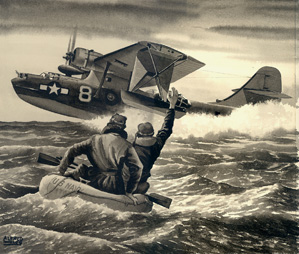
In an emergency could be mistaken for no other aircraft.





